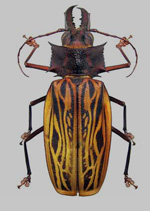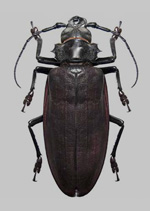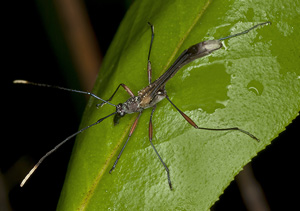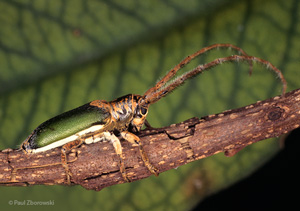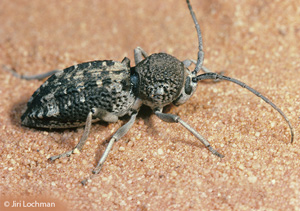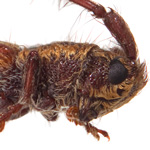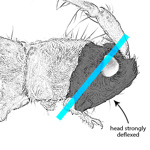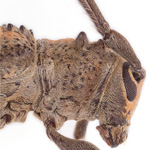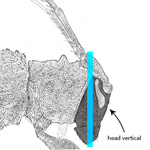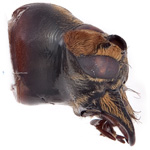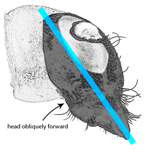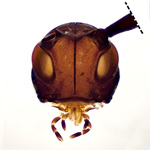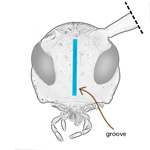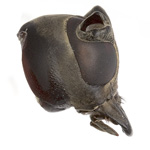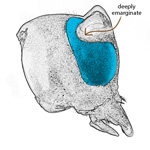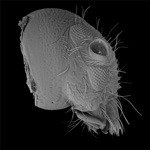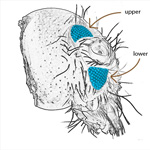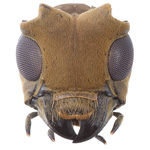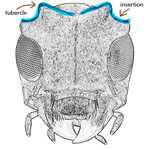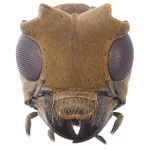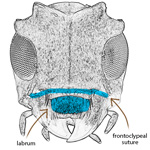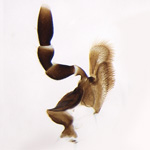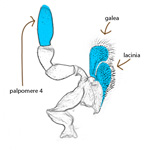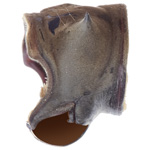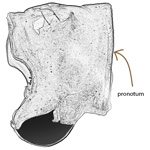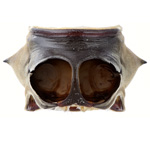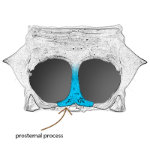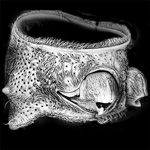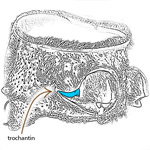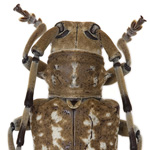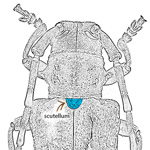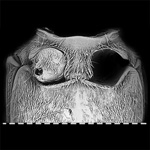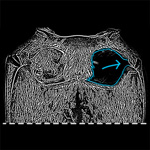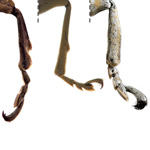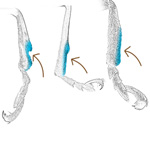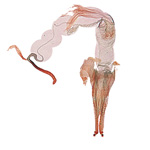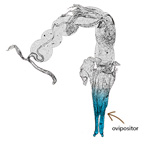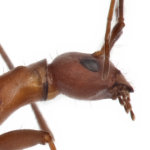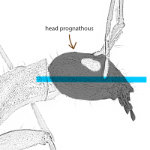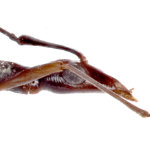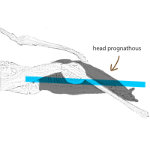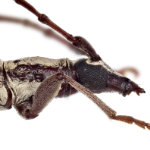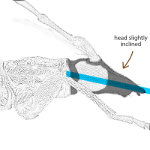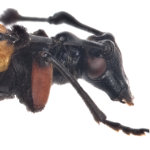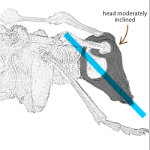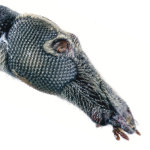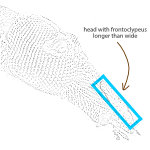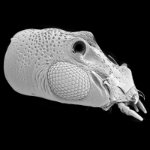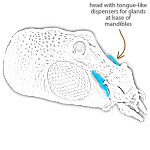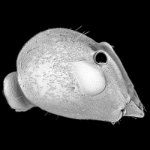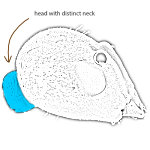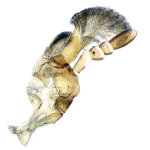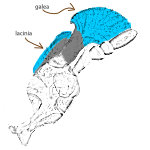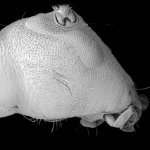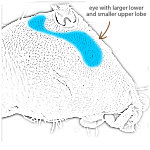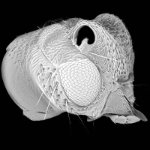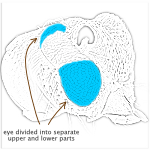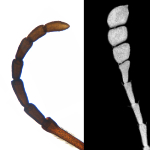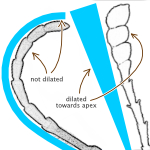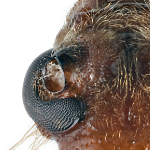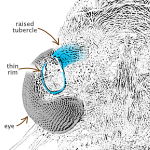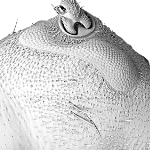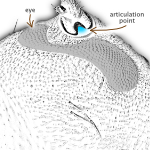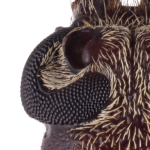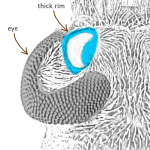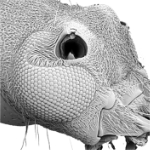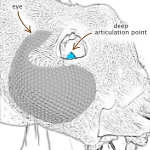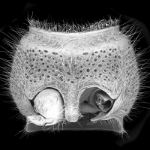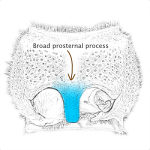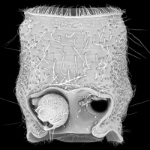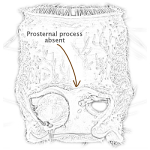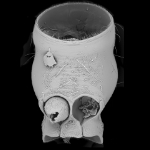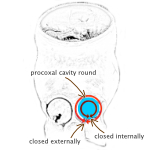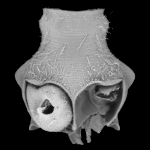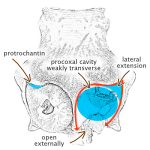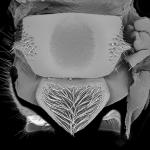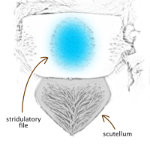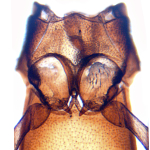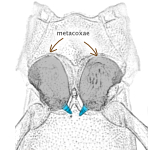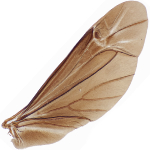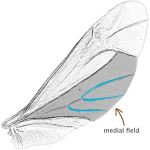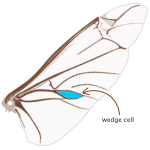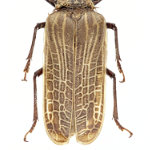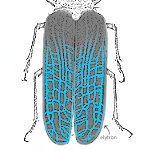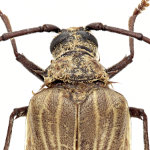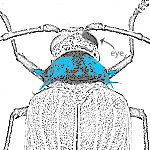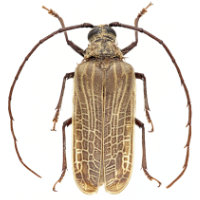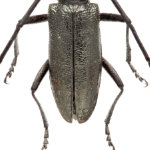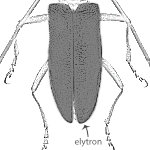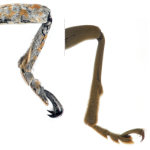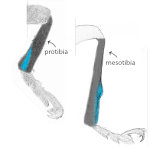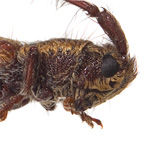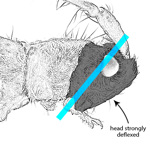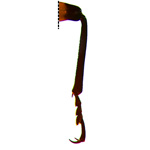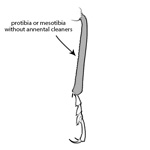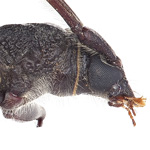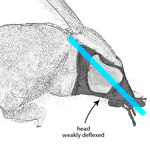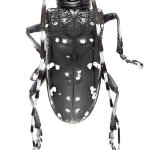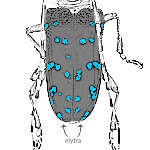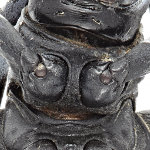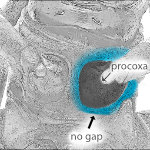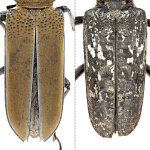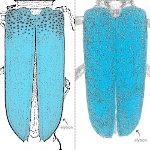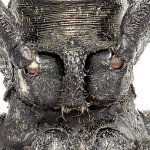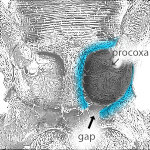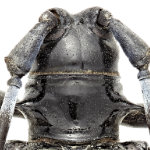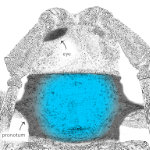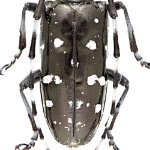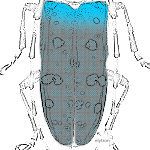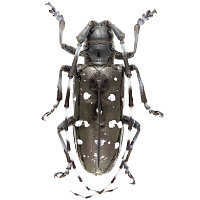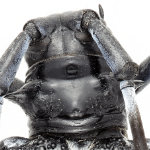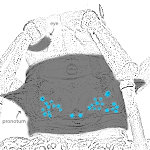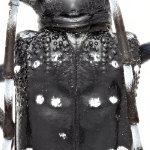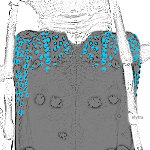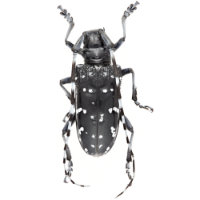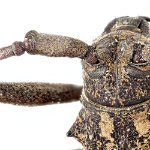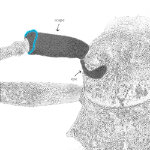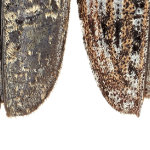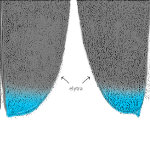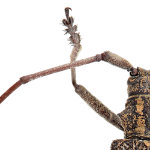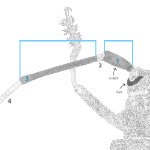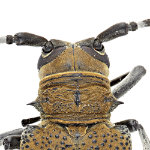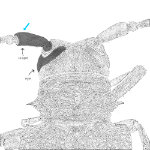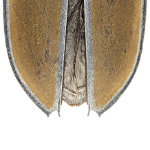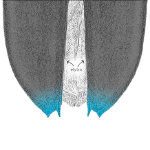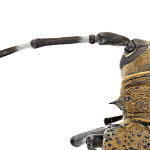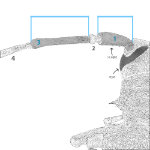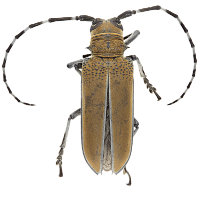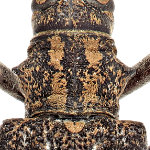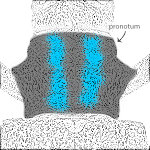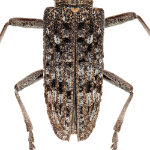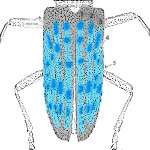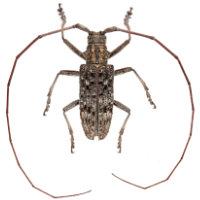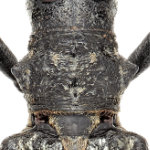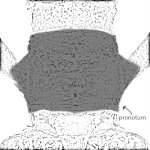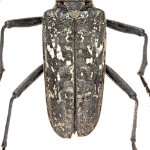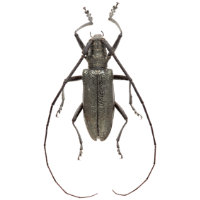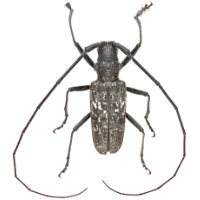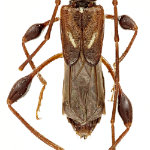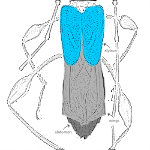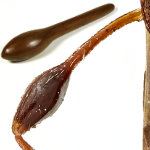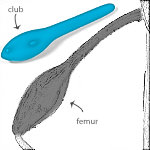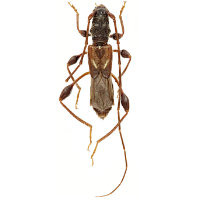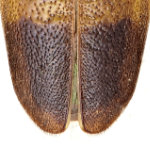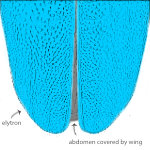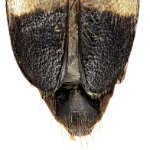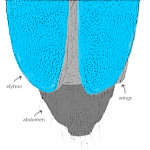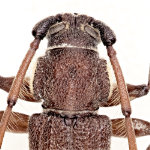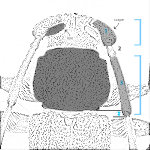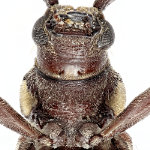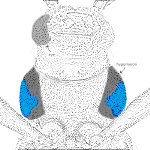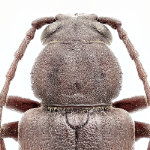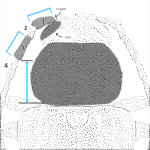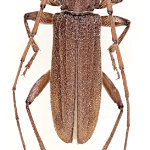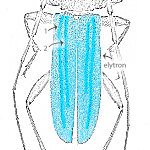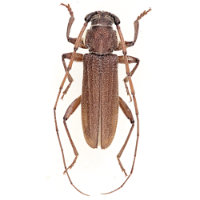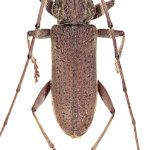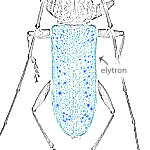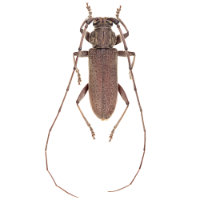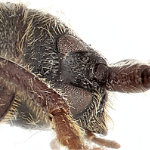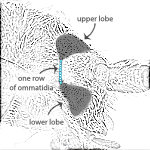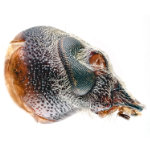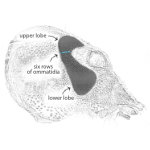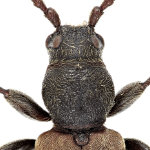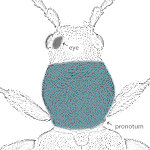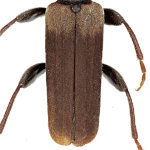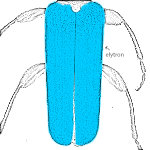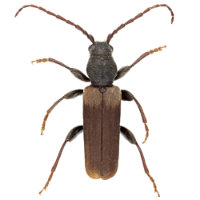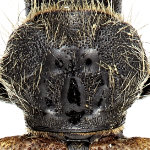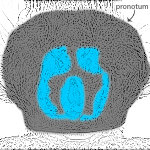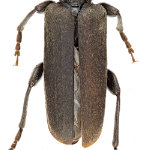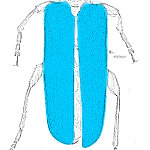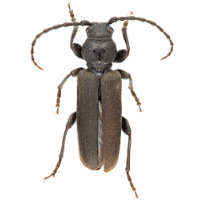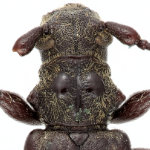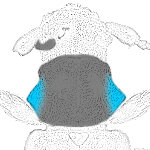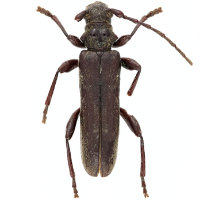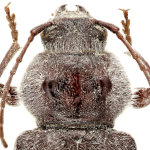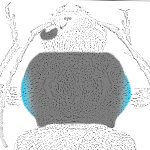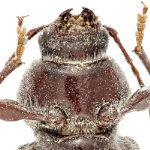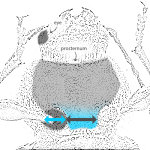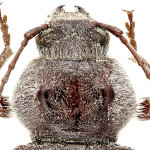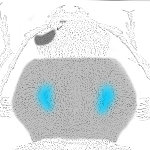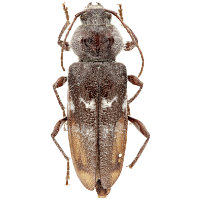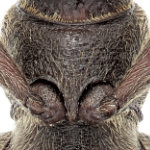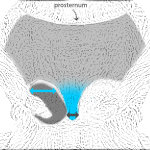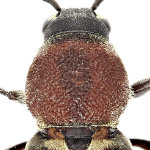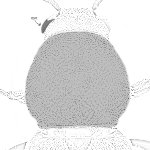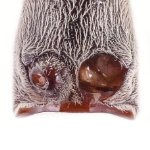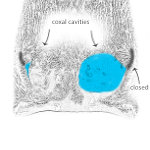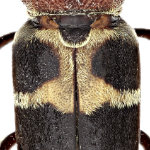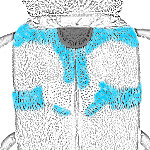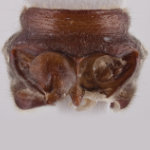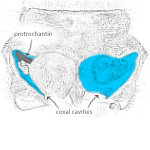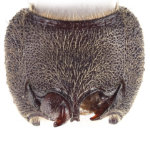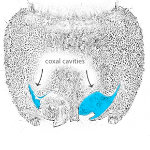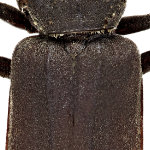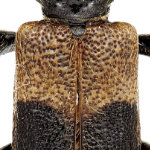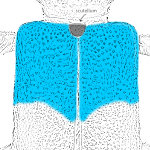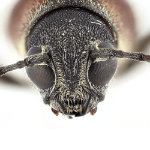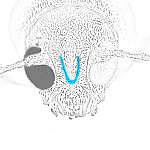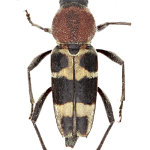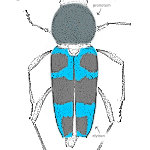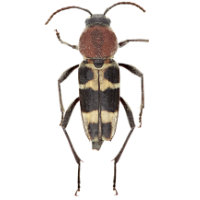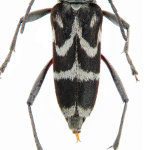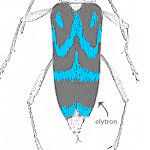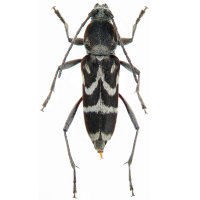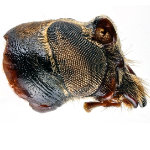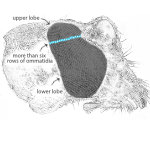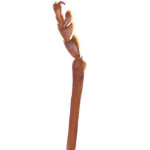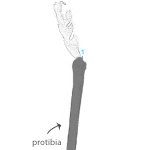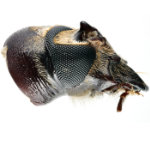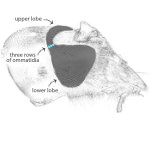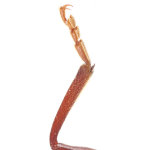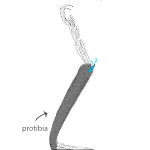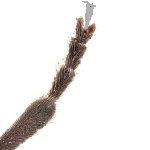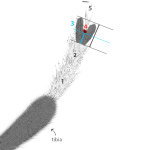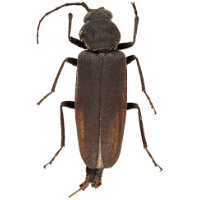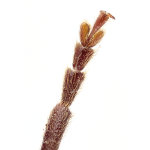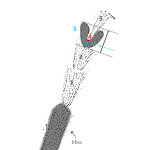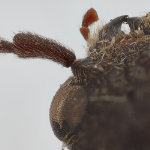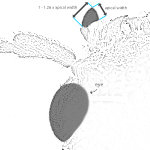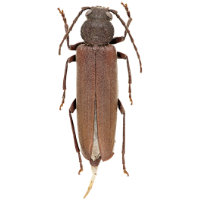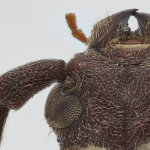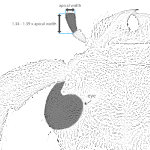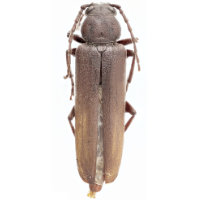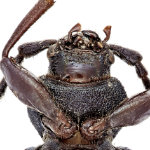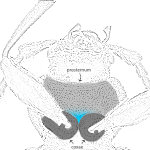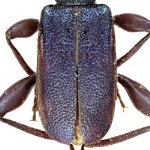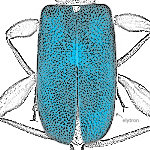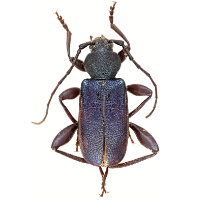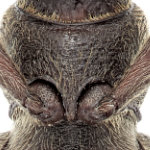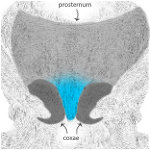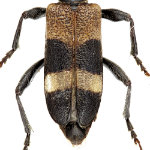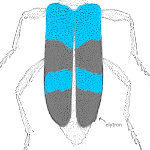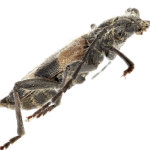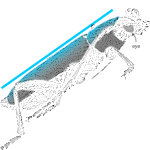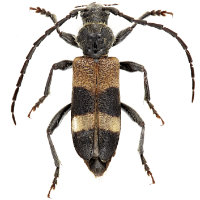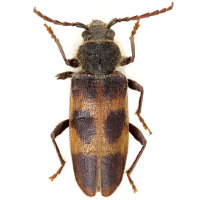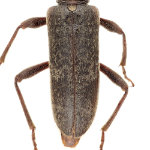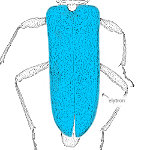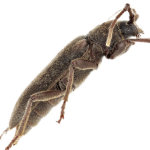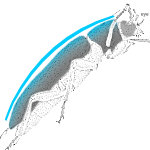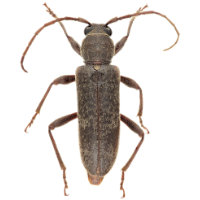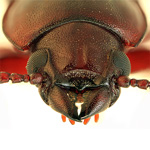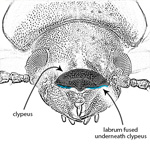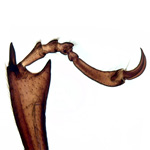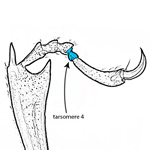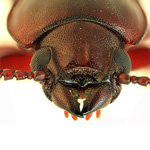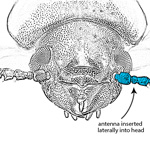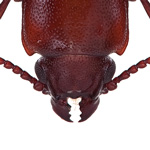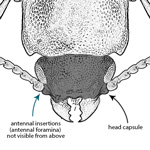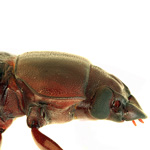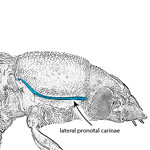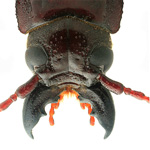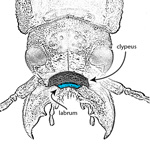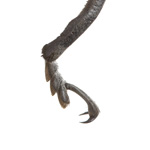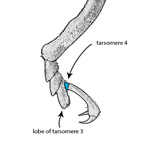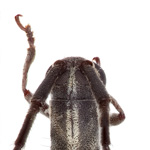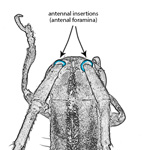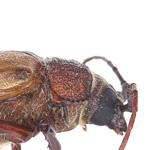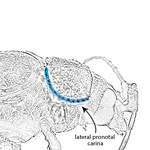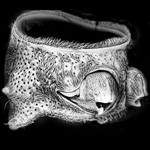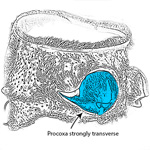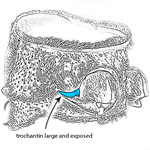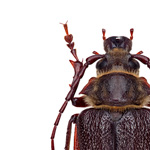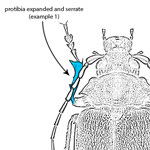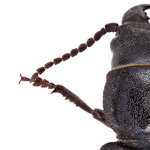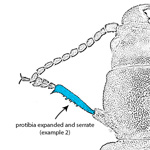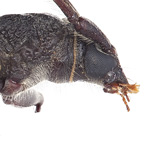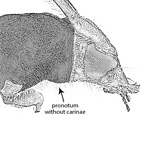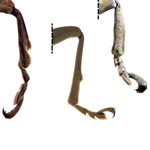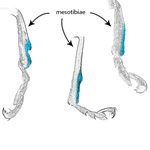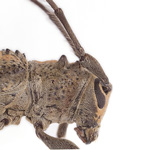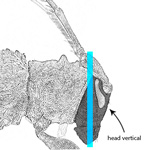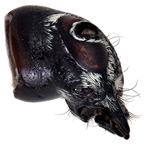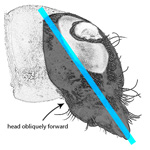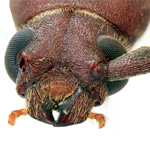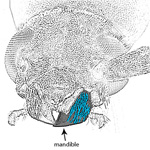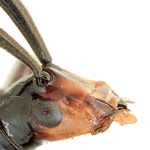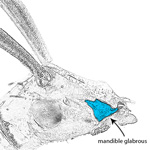Introduction
The Cerambycidae or longhorn beetles are among the most popular and easily recognised beetles and, for people who are more familiar with insects, mention of cerambycids invokes images of the largest and most iconic species, Titanus giganteus or Macrotoma heros from the Amazon forests in South America. Long antennae and rather elongate bodies are used as general diagnostic characteristics for these beetles. However, longhorn beetles come in all sizes, shapes and colours, even commonly mimicking unpalatable beetles, stinging ants or wasps and thus making scientific definition of the family rather difficult.
Larvae of longhorn beetles are mostly internal feeders, developing in living or dead plant tissues. They are capable of extracting nutrient compounds and microelements from that low energy source, aided by various symbiotic microorganisms and cellulolytic enzymes. They often utilise damaged or dead trees for their development and, through feeding on rotten wood form an important element of the saproxylic fauna, speeding wood decay and energy circulation in woodland habitats. Many species are pests of quarantine concern, attacking and killing forest or ornamental trees, spreading injurious nematodes or, by developing in seasoned wood, causing structural damage to timber constructions.
Evolutionarily, Cerambycidae are members of the Phytophaga, a highly derived group of polyphagous beetles that feed primarily on vascular plants as larvae and adults. This clade comprises Chrysomeloidea (longhorn beetles, seed beetles and leaf beetles) and Curculionoidea (weevils) and includes over 124,000 described species (Ślipiíski et al . 2011). The Phytophaga constitutes the largest known radiation of beetles, a radiation usually attributed to the the co-evolution of these phytophagous beetles and the rapidly radiating Angiosperm plants in the Tertiary (e.g. Farrell 1998). However, this attractive scenario has not been confirmed, at least for Chrysomeloidea (e.g. Gomez-Zurita et al. 2007), suggesting independent radiations of plants and phytophagous beetles driven by as yet unknown forces.
The division of Cerambycidae into subfamilies and tribes was gradually developed along with the first beetle classifications in 18th Century Europe and North America. It was quickly followed by a dedicated monographic study on Cerambycidae by Audinet-Serville, Thompson, LeConte, Pascoe, Lacordaire and Lameere, resulting in division of Cerambycidae into 7 major groups, usually treated as subfamilies: Disteniinae, Parandrinae, Spondylidinae, Prioninae, Aseminae, Lepturinae, Cerambycinae and Lamiinae. The advance of morphological research and use of novel larval characters in cerambycid classification provided support for many traditional groupings but highlighted some new divisions. There is now general agreement that the former Cerambycidae comprises four families, Oxypeltidae, Disteniidae, Vesperidae and Cerambycidae, of which only the largest family — Cerambycidae — occurs in Australia. The Cerambycidae, in this sense, includes approximately 33,000 described species. A large number of new taxa are being added constantly from all over the world but particularly from Asia and South America. The family is cosmopolitan but the largest subfamilies — Prioninae, Cerambycinae and Lamiinae — are most diverse in the tropical and subtropical parts of the world.
Subfamily level classification of Cerambycidae has been very unstable and proposed relationships between recognised subfamilies are mostly based on larval characters alone. Following Švácha and Lawrence (in press) we recognise eight subfamilies in Cerambycidae: Prioninae, Parandrinae, Dorcasominae, Cerambycinae, Spondylidinae, Necydalinae, Lepturinae, and Lamiinae. The Dorcasominae, Necydalinae and Lepturinae have restricted geographical distributions and do not occur in Australia, and the Spondylidinae are represented here only by two introduced species of Arhopalus. Cerambycidae are one of the largest families of Australian beetles, with over 300 described genera and 1,300 species. Yet despite their economic importance and obvious appeal to professional and amateur entomologists, they have been neglected for a long time. Published work on the Australian Cerambycidae has been very fragmentary and mostly limited to isolated species or generic descriptions, often without illustrations or a reference to the tremendous taxonomic difficulties within the generic and tribal classifications of most of subfamilies. The number of genera and species to be treated and the problems in higher classification have been the main impediments to research on this group in Australia. While actively participating in the international team working on higher classification of Cerambycidae that will take many years to publish, we decided to produce an overview and identification keys to Australian genera to facilitate further research on this group.
Biology
The vast world literature on cerambycid biology has been reviewed by Duffy (1953, 1963), Linsley (1959, 1961) and Švacha and Lawrence (in press). The information published so far is heavily biased towards a few economically important pest species and/or to generally better known species from the Palaearctic and Nearctic Regions.
Various aspects of biology of the Australian species were described in numerous early papers, mostly by D. Best (1881–1920), A.R. Brimblecombe (1943–1956) and W.W. Froggatt (1893–1930). These were summarised by Duffy (1963) who has described numerous larvae and provided new biological insight based on larval collecting data and unpublished information from his collaborators.
Later contributions to the knowledge of biology of the Australian Cerambycidae include many papers on pollination and host plants by G.A. Webb (1985–1997) and T.J. Hawkeswood and their collaborators (1985–2011). Food preferences Cerambycidae are phytophagous beetles.
Their larvae, called round-headed borers, develop in tissues of woody or herbaceous plants in conditions ranging from healthy and alive to dead and decomposing due to fungi (Duffy 1953). In addition to the standard set of digestive enzymes, the gut of cerambycid larvae contains cellulotic enzymes and yeast-like symbionts (in the mid gut) help to extract sugars and critical particles like nitrogen from the wood material (Švacha & Lawrence, in press). Some Australian cerambycids apparently are specialists confined to a single or a few plant species suitable for larval development, but many show amazingly broad host ranges that include native and introduced gymnosperms and angiosperms (Duffy 1963; Hawkeswood & Dauber 1991).
Hanks (1999) classified cerambycids into four categories based on the condition of the larval host plant at the time of colonisation. The species that attack healthy and vigorous plants are able to develop in stems of herbaceous plants and in twigs of woody plants, often inducing gall-like structures on the host plants.
All serious pest species classified in Lamiinae (e.g. Anaplophora, Monochamus) belong to this first category. In addition, some Lamiinae girdle branches of their hosts before oviposition (Stride & Warwick 1962), or their larvae are able to girdle the branches or roots internally during feeding (Linsley 1961).
Many Lamiinae and Cerambycinae colonise the host that has been attacked previously by bark borers or has been weakened by poor growing conditions, fire or flood. These species often are able to complete several generations on an individual tree and only exceptionally kill the host. The species in the third category, are able to colonise woody plants that are severely stressed and dying because of intense fire, drought or attack by bark beetles or nematodes; these species are able to complete only one generation before killing the host. The dead wooden hosts, often also infested by fungi, are then available for many generations of cerambycid species of the fourth category that develop in dead hosts until they decompose and are no longer suitable for their larvae.
Alphabetically down SearchGoOpen print version
SearchGoOpen print version![]()
References
Allison, J.D., Borden, J.H. & Seybold, S.J. (2004). A review of the chemical ecology of the Cerambycidae (Coleoptera).Chemoecology 14 : 123–150.
Audinet-Serville, J.G. (1832) Nouvelle classification de la famille des longicornes.Annales de la Société Entomologique de France1(2): 118–201.
Audinet-Serville, J.G. (1834) Nouvelle classification de la famille des longicornes(suite).Annales de la Société Entomologique de France3(1): 5–110.
Audinet-Serville, J.G. (1835) Nouvelle classification de la famille des longicornes (suite).Annales de la Société Entomologique de France4(1–2): 5–100, 197–228.
Aurivillius, C. (1893). Verzeichniss der von den Herren C. Lumholtz und C. Fristedt im nördlichen Queensland gesammelten Cerambyciden.Entomologisk Tidskrift1893: 153–169.
Aurivillius, C. (1911). Neue oder wenig bekannte Coleoptera Longicornia. 12.Arkiv för Zoologi 7 (19): 187–227 .
Aurivillius, C. (1912). Coleopterorum Catalogus, pars 39. Cerambycidae: Cerambycinae. W. Junk, Berlin, 574 pp.
Aurivillius, C. (1913). Neue oder wenig bekannte Coleoptera Longicornia. 13.Arkiv för Zoologi 8 (22): 1–35[ 229–263 ] .
Aurivillius, C. (1916). Neue oder wenig bekannte Coleoptera Longicornia. 16.Arkiv för Zoologi 10 (19): 1–25 [335–359].
Aurivillius, C. (1917). Results of Dr. E. Mjöberg's Swedish scientific expeditions to Australia 1910–1913, Part 12, Cerambycidae.Arkiv för Zoologi 10 (23): 1–50.
Aurivillius, C. (1920). Neue oder wenig bekannte Coleoptera Longicornia. 17.Arkiv för Zoologi 13 (9): 361–403.
Aurivillius, C. (1922a). Neue Cerambyciden aus der Sammlung G. van Roon. 3.Tijdschrift voor Entomologie 65 (1–3): 160–173.
Aurivillius, C. (1922b).Coleopterorum Catalogus, pars 73. Cerambycidae: LamiinaeI. W. Junk, Berlin, pp. 1–322.
Aurivillius, C. (1923).Coleopterorum Catalogus, pars 74. Cerambycidae: Lamiinae II . W. Junk, Berlin. pp. 323–704.
Aurivillius, C. (1926). Neue oder wenig bekannte Coleoptera Longicornia. 21.Arkiv för Zoologi[1925]18A(9): 503–524.
Aurivillius, C. (1927). Neue oder wenig bekannte Coleoptera Longicornia. 22.Arkiv för Zoologi 19A (17): 525–547 [1–23].
Aurivillius, C. (1928). Cerambycidae.inInsects of Samoa and Other Samoan Terrestrial Arthropoda.British Museum (Natural History)4 (2): 135–154.
Austin, A.D., Quicke, D.L.J. & Marsh, P.M. (1994). The hymenopterous parasitoids of eucalypt Longicorn beetles,Phoracanthaspp. (Coeloptera: Cerambycidae) in Australia.Bulletin of Entomological Research, 84 : 145-174.
Bashford, R. (1990). Tasmanian forest insects and their host plants: records from the Tasmanian Forestry Commission insect collection. Hobart: Tasmanian Forestry Commission, 32 pp.
Bashford, R. (1991). Wood-boring Coleoptera and associated insects reared from Acacia dealbata Link in Tasmania. Australian Entomological Magazine18(3): 103–110.
Bates, H.W. (1873). On the longicorn Coleoptera of Japan.Annals and Magazine of Natural History 4 (12): 308–318.
Bates, H.W. (1874). On the longicorn Coleoptera of New Zealand.Annals and Magazine of Natural History14 : 118–131.
Bates, H.W. (1879–1885). Longicornia. pp. 1–436inGodman, F.D. & Salvin, O. (eds),Biologia Centrali-Americana.Insecta, Coleoptera. Vol. V. London, Porter.
Bates, H.W. (1884). Longicorn beetles of Japan. Additions, chiefly from the later collections of Mr. George Lewis; and notes on the synonymy, distribution, and habits of the previously known species.Journal of the Linnean Society of London(Zoology)18 : 205–262.
Bates, H.W. (1885). Insecta, Coleoptera. Supplement to Longicornia.Biologia Centrali–Americana . London. Vol. 5: 249–436, pls XVII–XXIV.
Blackburn, T. (1889). Further notes on Australian Coleoptera with descriptions of new genera and species.Proceedings of the Linnean Society of New South Wales(2) 3 : 1387–1506.
Blackburn, T. (1890a). Further notes on Australian Coleoptera with descriptions of new genera and species. Part VIII.Transactions of the Royal Society of South Australia 13 : 121–160.
Blackburn, T. (1890b). Notes on Australian Coleoptera with descriptions of new species. Part IV.Proceedings of the Linnean Society of New South Wales(2) 4 : 707–746.
Blackburn T. (1892a). Further notes on Australian Coleoptera, with descriptions of new genera and species. Part X. Proceedings of the Royal Society of New South Wales( 2) 6 : 479–550.
Blackburn, T. (1892b). Further notes on Australian Coleoptera with descriptions of new genera and species. Part XII.Transactions of the Royal Society of South Australia 15 : 207–261.
Blackburn, T. (1893). Scientific results of the Elder Exploring Expedition: Coleoptera (continued). Transactions of the Royal Society of South Australia 16 : 177–202.
Blackburn, T. (1894a). Notes on Australian Coleoptera with descriptions of new species. Part XIII.Proceedings of the Linnean Society of New South Wales(2) 8 : 185–208.
Blackburn, T. (1894b). Notes on Australian Coleoptera, with descriptions of new genera and species. Part XV.Proceedings of the Linnean Society of New South Wales(2) 9 : 85–108.
Blackburn, T. (1894c). Further notes on Australian Coleoptera with descriptions of new genera and species. Part XV.Transactions of the Royal Society of South Australia 18 : 139–168.
Blackburn, T. (1895). Further notes on Australian Coleoptera with descriptions of new genera and species. Part XVIII.Transactions of the Royal Society of South Australia 19 : 201–258.
Blackburn, T. (1896). Coleoptera (exclusive of the Carabidae). pp. 254–308inSpencer, B. (ed.) Report on the work of the Horn Scientific Expedition to Central Australia. Part II. Zoology. London, Dulau.
Blackburn, T. (1897a). Further notes on Australian Coleoptera with descriptions of new genera and species. Part XXI.Transactions of the Royal Society of South Australia21 : 28–39.
Blackburn, T. (1897b). Further notes on Australian Coleoptera with descriptions of new genera and species. Part XXII.Transactions of the Royal Society of South Australia21 : 88–98.
Blackburn, T. (1901). Further notes on Australian Coleoptera with descriptions of new genera and species. Part XXVIII.Transactions of the Royal Society of South Australia 25 : 15–44.
Blackburn, T. (1902). Further notes on Australian Coleoptera, with descriptions of new genera and species. Part XXXI.Transactions of the Royal Society of South Australia 26 : 288–321.
Blackburn, T. (1908). Further notes on Australian Coleoptera with descriptions of new genera and species. Part XXXVIII.Transactions of the Royal Society of South Australia 32 : 362–386.
Blair, K.G. (1933). A new Longicorn (Lamiidae) from Christmas Island, Indian Ocean.Bulletin of the Raffles Museum 8 : 97.
Blanchard, C.É. (1845).Histoire des Insectes, traitant de leurs moeurs et de leurs métamorphoses en général, et comprenant une nouvelle classification fondée sur leurs rapports naturels . Paris, Didot Frères, Vol.2 , 524 pp.
Blanchard, C.É. (1853). Description des Insectes.InHombron, M. & Jacquinot, H. V oyage au Pôle Sud et dans l'Océanie sur les corvettes l'Astrolabe et la Zélée ...Paris, Baudry. Atlas Zoologie [1842–1853], Vol. 4, 442 pp. (Insecta, 25 pls).
Boisduval, J.B.A. (1835).Voyage de Découvertes de l'Astrolabe e xécuté par ordre du Roi, pendant les années 1826–1827–1828–1829, sous le commandement de M.J. Dumont d'Urville.Faune entomologique de l'Océan Pacifique, avec l'illustration des insectes nouveaux recueillis pendant le voyage. Deuxième partie. Coléoptères et autres ordres . Paris, J. Tastu, vii + 716 pp.
Boppe, P.L. (1921)Coleoptera Longicornia. Fam. Cerambycidae.Subfam. Disteniinae-Lepturinae. Genera Insectorum.Fascicule178. Verteneuil, V. & Desmet, L. (ed.), Bruxelles, 121 pp. + 8 Tab.
Bouchard, P., Bousquet, Y., Davies, A.E., Alonso–Zarazaga, M.A., Lawrence, J.F., Lyal, C.H.C., Newton, A.F., Reid, C.A.M., Schmitt, M., Ślipiński, S.A. & Smith, A.B.T. (2011). Family-group names in Coleoptera (Insecta).ZooKeys 88 : 1–972.
Bousquet, Y. (2007). Nomenclatural and bibliographic notes on Cerambycidae (Coleoptera).Coleopterists Bulletin 61 (4): 616–631.
Bousquet, Y., Heffern, D.J., Bouchard, P. & Nearns, E. (2009). Catalogue of family–group names in Cerambycidae (Coleoptera).Zootaxa 2321 : 1–80.
Bousquet, Y. & Bouchard, P. (2013). The genera in the second catalogue (1833–1836) ofDejean's Coleoptera collection.ZooKeys 282 : 1–219.
Böving, A.G. & Craighead, F.C. (1931). An illustrated synopsis of the principal larval forms of the order Coleoptera.Entomologica Americana(N.S.) 11 (1)[1930]: 1–351.
Breuning, S. (1936). Novae species Cerambycidarum V. Festschrift zum 60,Geburtstage von Professor Dr. Embrik Strand1 : 274–326.
Breuning, S. (1938a). Novae species Cerambycidarum VI.Festschrift zum 60, Geburtstage von Professor Dr. Embrik Strand 4 : 180–392.
Breuning, S. (1938b). Nouveaux Cerambycidae (Col.).Novitates Entomologicae 8 : 30–63.
Breuning, S. (1938c). Einige neue cerambyciden aus den sammlungen des Nationalmuseums Prag. (Col.).Acta Entomologica Musei Nationalis Pragae Cechoslovakensis 16 : 93–96.
Breuning, S. (1939a). Novae species Cerambycidarum VII.Festschrift zum 60. Geburtstage von Professor Dr. Embrik Strand 5 : 144–290.
Breuning, S. (1939b). Neue Lamiinae (Cerambycidae, Coleoptera) aus dem Museo Civico di Storia Naturale in Genua.Memorie della Società Entomologica Italiana18 : 53–79.
Breuning, S. (1940a). Novae species Cerambycidarum VIII.Folia Zoologica et Hydrobiologica 10 (1): 37–85.
Breuning, S. (1940b). Novae species Cerambycidarum IX.Folia Zoologica et Hydrobiologica 10 (1): 115–214.
Breuning, S. (1940c). Novae species Cerambycidarum X.Folia Zoologica et Hydrobiologica 10 (2): 407–437.
Breuning, S. (1940d). Études sur les Lamiaires (Coleoptera: Cerambycidae). Neuvième tribu: Dorcaschematini Thoms.Novitates Entomologicae, Revue Mondiale d'Entomologique Systématique — Biologie. Troisième Supplément 11 (66–71): 527–568.
Breuning, S. (1942). Novae species Cerambycidarum XI.Folia Zoologica et Hydrobiologica 11 (2): 113–175.
Breuning, S. (1943a). Novae species Cerambycidarum XII.Folia Zoologica et Hydrobiologica 12 (1): 12–66.
Breuning, S. (1943b). Études sur les Lamiaires (Coleoptera: Cerambycidae). Douzième tribu: Agniini Thomson.Novitates Entomologicae. Revue Mondiale d'Entomologique Systématique – Biologie. Troisième Supplément 13 (89–106): 137–280.
Breuning, S. (1944). Études sur les Lamiaires (Coleoptera: Cerambycidae). Douzième tribu: Agniini Thomson.Novitates Entomologicae, Revue Mondiale d'Entomologique Systématique—Biologie. Troisième Supplément 14 (107–135): 281–512.
Breuning, S. (1945). Études sur les Lamiaires (Coleoptera: Cerambycidae). Quatorzième tribe: Tmesisternini Thomson.Novitates Entomologicae, Revue Mondiale d'Entomologique Systématique — Biologie. Troisième Supplément 16 (139–147): 537–608.
Breuning, S. (1947). Nouvelles formes de Longicornes du Musée de Stockholm.Arkiv för Zoologi 39A (6): 1–68.
Breuning, S. (1948a). Nouvelles formes de Lamiaires (première partie).Bulletin du Musée Royal d'Histoire Naturelle de Belgique 24 (38): 1–44.
Breuning, S. (1948b). Nouvelles formes de Lamiaires (deuxième partie).Bulletin du Musée royal d'Histoire naturelle de Belgique24 (47): 1–47.
Breuning, S. (1949) Notes systématiques sur les Lamiaires.Bulletin de l'Institut royal des Sciences naturelles de Belgique 25 (38): 1–32.
Breuning, S. (1950a). Quelques nouveaux Lamiaires (Coleoptera, Cerambycidae) du Riksmuseum.Arkiv för Zoologi 1 (19): 265–274.
Breuning, S. (1950b). Révision des Parmenini.Longicornia 1 : 29–159.
Breuning,S. (1950c). Revision des Homonoeini.Longicornia 1 : 317–377.
Breuning, S. (1953). Nouvelles formes de Lamiaires (4e partie).Bulletin de l'Institut royal des Sciences naturelles de Belgique 29 (8): 1–38.
Breuning, S. (1954). Nouvelles formes de Lamiaires (5eme partie).Bulletin de l'Institut royal des Sciences naturelles de Belgique 30 (11): 1–23.
Breuning, S. (1956a). Revision der GattungGleneaNewm.Entomologischen Arbeiten aus dem Museum G. Frey 7 (1): 1–199.
Breuning, S. (1956b). Einige neue Lamiinae aus der Sammlung des Museums G. Frey (Coleoptera, Cerambycidae).Entomologische Arbeiten aus dem Museum G. Frey 7 (1) : 200–202.
Breuning, S. (1956c). Lamiaires nouveaux de la collection Lepesme (2e note).Longicornia 3 : 663–702.
Breuning, S. (1956d). Longicornes nouveaux de la Collection du Museo Civico di Storia Naturale — Genova.Annali del Museo Civico di Storia Naturale Giacomo Doria 68 : 244–258.
Breuning, S. (1956e). Revision des Astathini.Longicornia 3 : 417–519.
Breuning, S. (1956f). Notes sur les Lamiaires.Longicornia 3 : 703–722.
Breuning, S. (1957). Sechs neue Lamiiden aus dem Museum G. Frey (Ceramb., Col.).Entomologische Arbeiten aus dem Museum G. Frey 8 (2): 683–686.
Breuning, S. (1958a). Nouvelles formes de Lamiaires (dixième partie).Bulletin de l'Institut royal des Sciences naturelles de Belgique34 (22): 1–47.
Breuning, S. (1958b). Révision du genreExocentrusMulsant (Col., Cerambycidae).Bulletin of the British Museum (Natural History), Entomology 7 (5): 211–320.
Breuning, S. (1958c). Révision des espèces africaines du genreNupserhaThoms. (Col. Cerambycidae).Bulletin de l'Institut Fondamental d'Afrique Noire 20A (2): 369–456.
Breuning, S.(1958d).Catalogue des Lamiares du Monde (Col. Céramb.). 1. Lieferung . Tutzing bei München, Museum G. Frey, pp. 1–48.
Breuning, S. (1959a). Neue Cerambyciden aus den Sammlungen des Zoologischen Museums der Humboldt-Universität zu Berlin (Coleoptera, Cerambycidae).Mitteilungen aus dem Zoologischen Museum in Berlin 35 : 149–175.
Breuning, S. (1959b). Neue und bemerkenswerte K ä fer-Formen aus der Sammlung des zollogischen Forschunsinstituts und Museums Alexander Koenig. 5. Lamiiden.Bonner Zoologische Beiträge10 : 126–131.
Breuning, S. (1959c). Nouveaux genres de Lamiinae (Coleoptera, Cerambycidae).Bulletin et Annales de la Société Entomologique de Belgique 95 (1–4): 70–88.
Breuning, S. (1959d). Nouvelles formes de Lamiaires (Onzième partie).Bulletin de l'Institut royal des Sciences naturelles de Belgique 35 (6): 1–14.
Breuning, S.(1959e).Catalogue des Lamiares du Monde (Col. Céramb.). 2. Lieferung . Tutzing bei München, Museum G. Frey, pp. 49–107.
Breuning, S. (1960a). Nouvelles formes de Lamiaires (Douzième partie).Bulletin de l'Institut royal des Sciences naturelles deBelgique36 (7): 1–30.
Breuning, S. (1960b). Révision des espèces asiatiques du genreNupserhaThomson (Coleoptera, Cerambycidae).Bulletin de l'Institut royal des Sciences naturelles de Belgique 36 (10): 1–62.
Breuning, S. (1960c). Révision systématique des espèces du genreObereaMulsant du globe (Coleoptera, Cerambycidae).Frustula Entomologica 3 (4):1–59.
Breuning, S. (1960d).Catalogue des Lamiaires du monde (Col. Céramb.). 3 Lieferung . Tutzing bei München, Museum G. Frey, pp. 109–182.
Breuning, S. (1961a).Catalogue des Lamiaires du monde (Col. Céramb.). 4 Lieferung .Tutzing bei München, Museum G. Frey , pp. 183–284.
Breuning, S. (1961b).Catalogue des Lamiaires du monde (Col. Céramb.). 5 Lieferung . Tutzing bei München, Museum G. Frey , pp.285 – 382.
Breuning, S. (1961c). Neue oder schlecht bekannte Cerambyciden (Col.).Entomologische Arbeiten aus dem Museum G. Frey 12 (1): 140–160.
Breuning, S. (1961d). Nouvellles formes de Lamiaires (Treizième Partie).Bulletin de l'Institut royal des Sciences naturelles de Belgique 37 (20): 1–44.
Breuning, S. (1961e). Nouveaux Cerambycidae des collections du Muséum de Paris.Bulletin du Muséum National d'Histoire Naturelle (1960)(2) 32 (6): 536–548.
Breuning, S. (1961f). Neue Cerambyciden aus den sammlungen des Zoologischen Museums der Humboldt–Universität zu Berlin (Coleoptera, Cerambycidae).Mitteilungen aus dem Zoologischen Museum in Berlin 37 (2): 297–328.
Breuning, S. (1961g). Révision systématique des espèces du genreObereaMulsant du globe (Coleoptera Cerambycidae) (deuxième partie).Frustula Entomologica 4 (3): 61–140.
Breuning, S. (1961h). Révision des Pteropliini de l'Afrique noire (première partie).Bulletin de l'Institut Fondamental d'Afrique Noire 23A (2): 452–484.
Breuning, S. (1962a). Nouveaux lamiaires du British Museum (Natural History) (Col. Cerambycidae).Annals and Magazine of Natural History(13) 5 : 233–241.
Breuning, S. (1962b).Catalogue des Lamiaires du monde (Col. Céramb.). 6 Lieferung . Tutzing bei München, Museum G. Frey, pp. 387–459.
Breuning, S. (1962c). A contribution to the knowledge of the Lamiinae (Coleoptera, Cerambycidae) of New Zealand.Transactions of the Royal Society of New Zealand (Zoology)2 (13): 73–108.
Breuning, S. (1962d). Révision systématique des espèces du genreObereaMulsant du globe (Coleoptera Cerambycidae) (troisième partie).Frustula Entomologica 5 (4): 141–232.
Breuning, S. (1962e).Bestimmungstabelle der Lamiiden–Triben nebst Revision der Pteropliini der asiatischen Region.(Col. Ceramb.) I. Teil.Entomologischen Arbeiten aus dem Museum G. Frey 13 (2): 371–493.
Breuning, S. (1963a). Revision der Pteropliini der australischen region (Coleoptera, Cerambycidae).Entomologische Abhandlungen aus dem Staatliches Museum für Tierkunde in Dresden 29 (1): 1–274.
Breuning, S. (1963b). Neue Lamiinae aus dem Museum G. Frey.Entomologische Arbeiten aus dem Museum G. Frey 14 (2): 446–455.
Breuning, S.(1963c).Catalogue des Lamiares du Monde (Col. Céramb.). 7. Lieferung . Tutzing bei München, Museum G. Frey, pp. 463–555.
Breuning, S. (1964a). Tribus Apomecynini, Revision der Apomecynini der Asiatisch–Australischen Region.Entomologische Abhandlungen und Berichte aus dem Staatlichen Museum für Tierkunde in Dresden 30 : 1–528.
Breuning, S. (1964b). Neue Lamiinae (Col. Cerambycidae) aus den Beständen des Museums G. Frey.Entomologische Arbeiten aus dem Museum G. Frey 15 (2): 725–730.
Breuning, S. (1965a). Revision der 35. Gattung der Pteropliini der asiatischen Region (Col. Cerambycidae).Entomologischen Arbeiten aus dem Museum G. Frey 16 :161–472.
Breuning, S. (1965b). Neue Cerambyciden aus den Sammlungen des Zoologischen Museums der Humboldt–Universität zu Berlin (Coleoptera, Cerambycidae) (vierter teil).Mitteilungen aus dem Zoologischen Museum in Berlin 41 (1): 81–93.
Breuning, S. (1966a). Nouvelles formes de Lamiaires (dix–septième partie).Bulletin de l'Institut royal des Sciences naturelles de Belgique 42 (21): 1–22.
Breuning, S. (1966b).Catalogue des Lamiaires du Monde (Col. Céramb.). 9 Lieferung . Tutzing bei München, Museum G. Frey, pp. 659–765.
Breuning, S. (1966c). Revision der Agapanthiini der Eurasiatisch–Australischen Region (Coleoptera, Cerambycidae).Entomologische Abhandlungen und Berichte aus dem Staatlichen Museum für Tierkunde in Dresden 34 : 1–144.
Breuning, S. (1967).Catalogue des Lamiaires du Monde (Col. Céramb.) . Tutzing bei München, Museum G. Frey , pp. 771–864.
Breuning, S. (1968).Nouveaux Lamiaires de la collection Fuchs (Col. Cerambycidae).Bulletin de la Société Entomologique de Mulhouse 1968 (Juillet – Aout): 53–57.
Breuning, S. (1969). Nouveaux coléoptères Cerambycidae Lamiinae des collections du Muséum de Paris.Bulletin du Muséum National d'Histoire Naturelle(2e Série)41 (1): 187–199.
Breuning, S. (1970a). Nouveaux Coléoptères Cerambycidae Lamiinae des collections du Muséum de Paris.Bulletin du Muséum National d'Histoire Naturelle(2) 42 (3): 460–488.
Breuning, S. (1970b). Révision des Nyctimenini, Hyborhabdini et Zygocerini (Coleoptera, Cerambycidae, Lamiinae).Bulletin et Annales Société Entomologique de Belgique 106 : 77–117.
Breuning, S. (1970c). Beschreibung einiger neuer Lamiiden (Coleoptera, Cerambycidae) der Sammlung Fuchs.Koleopterologische Rundschau 48 : 9–11.
Breuning, S. (1972). Descriptions de cinq nouvelles espèces de Lamiinae de la coll. Chassot (Col. Cerambycidae).Bulletin de la Société Entomologique de Mulhouse 1972 : 29–31.
Breuning, S.(1973). Neue Lamiinen (Coleoptera, Cerambycidae) aus der Sammlung des Ungarischen Naturwissenschaftlichen Museums.Folia Entomologica Hungarica( n.s. ) 26 : 9–17.
Breuning, S. (1974).Neue Lamiinae (Coleoptera, Cerambycidae).Mitteilungen aus dem Zoologischen Museum in Berlin 50 (2): 237–241.
Breuning, S. (1975a). Neue Lamiinen aus Queensland (Coleoptera: Cerambycidae).Folia Entomologica Hungarica( n.s. ) 28 (1): 5–7.
Breuning, S. (1975b). Révision de la tribu des Rhodopinini Gress. de la région Asiato–Australienne (Coleoptera, Cerambycidae) (première partie).Editions Sciences Nat1975:1-70.
Breuning, S. (1976). Révision de la tribu des Rhodopinini Gress. de la région Asiato–Australienne (Coleoptera, Cerambycidae) (deuxième partie).Editions Sciences Nat1975:71–151.
Breuning, S. (1977a). Révision de la tribu des Acanthocinini de la région Asiato–Australienne (Coleoptera: Cerambycidae) (deuxième partie).Mitteilungen aus dem Zoologische Museum in Berlin 53 (2): 199–276.
Breuning, S. (1977b). Quelques rectifications systématiques sur les Lamiaires.Bulletin de la Société Entomologique de Mulhouse1977(Oct–Dec.): 59–60.
Breuning, S. (1978a). Révision de la tribu des Acanthocinini de la région Asiato–Australienne (Coleoptera: Cerambycidae) (troisième partie).Mitteilungen aus dem Zoologischen Museum in Berlin 54 (1): 3–78.
Breuning, S. (1978b). Nouvelles espèces de Lamiinae (Cerambycidae) de la coll. Vives.Miscellania Zoologica 4 (2): 131–136.
Breuning, S. (1979a). Descriptions de nouveaux genres et espèces de Lamiinae (Col. Cerambycidae).Bulletin de la Société Entomologique de Mulhouse 1979 (Jan–Mar): 13–15.
Breuning, S. (1979b). Révision de la tribu des Gyaritini Breun. (Coleoptera Cerambycidae).Editions Sciences Nat1979: 1–20.
Breuning, S. (1980). Nouveaux Lamiinae de Nouvelle–Guinée (Col. Cerambycidae).Bulletin de la Société Entomologique de France 85 : 130–134.
Breuning, S. (1982). Diagnoses préliminaires de nouveaux Lamiinae du Muséum National d'Histoire Naturelle de Paris [Coleoptera, Cerambycidae].Annales de la Société Entomologique de France( n.s. ) 18 (1): 9–29.
Breuning, S. (1984). Notice autobiographique & liste des publications. Bulletin de la Société Sciences Nat41 : 1-17.
Breuning, S. & de Jong, C. (1941). Neue und seltene Lamiinae (Coleoptera, Cerambycidae).Zoologische Mededeelingen 23 : 47–106.
Britton, E.B.(1970). Coleoptera (beetles). pp. 495–621inCSIRO (ed.)The Insects of Australia. A Textbook for Students and Research Workers . Melbourne University Press, Carleton, Victoria.
Broun, T. (1893). Manual of the New Zealand Coleoptera. Parts V, VI, VII. Wellington, Samuel Costall, pp. i–xvii + 975–1504.
Brun, L.O. & Chazeau, J. (1980).Catalogue des ravageurs d'interet agricole de Nouvelle Calédonie.Nouméa, New Caledonia, ORSTOM.
Butovitsch, V. (1939). Zur Kenntnis der Paarung, Eiablage und Ernährung der Cerambyciden. Entomologisk Tidskrift60 : 206-258.
Calder, A.A. (2000). Relationships of the genera of Australian Strongylurini (Coleoptera: Cerambycidae).Invertebrate Taxonomy 14 : 863–870.
Carter, H.J. (1926). Revision ofAthemistusandMicrotragus(Fam. Cerambycidae) with notes, and descriptions of other Australian Coleoptera.Proceedings of the Linnean Society of New South Wales51 : 492–516.
Carter, H.J. (1928). Revision of the Australian species of the generaCuris ,NeocurisandTrachys , together with notes and descriptions of new species of other Coleoptera.Proceedings of the Linnean Society of New South Wales52 : 270–290.
Carter, H.J. (1929). Australian Coleoptera, notes and new species. VI.Proceedings of the Linnean Society of New South Wales54 : 65–79.
Carter, H.J. (1932). New Guinea and Australian Coleoptera. Notes and new species. II.Proceedings of the Linnean Society of New South Wales 57 : 101–115.
Carter, H.J. (1933). Australian Coleoptera. Notes and new species. VIII.Proceedings of the Linnean Society of New South Wales 58 : 159–180.
Carter, H.J. (1934). Australian and New Guinea Coleoptera. Notes and new species. III.Proceedings of the Linnean Society of New South Wales54 : 252–269.
Carter, H.J. (1937). Some new Tenebrionidae in the South Australian Museum; together with notes and descriptions of other Australian Coleoptera.Transactions of the Royal Society of South Australia 61 : 121–144.
Castelnau, F.L. Laporte de (1840).Histoire Naturelle des Insectes Coléoptères . Paris, P. Duméril Vol. 2, 563 pp.
Cherepanov, A.I. (1990). C erambycidae of Northern Asia (Lamiinae), vol. 3 part I . New Delhi ,Oxonian Press 300 pp. [translation of Usachi Severnoi Azii (Lamiinae) Russian version 1983. Novosibirsk, Nauka]
Cherepanov, A.I. (1991a).Cerambycidae of Northern Asia (Lamiinae), vol. 3 part II . New Delhi, Oxonian Press 395 pp. [translation of Usachi Severnoi Azii (Lamiinae) Russian version 1983?, Novosibirsk, Nauka]
Cherepanov, A.I. (1991b).Cerambycidae of Northern Asia (Lamiinae), vol. 3 part III . New Delhi, Oxonian Press, 395 pp. [translation of Usachi Severnoi Azii (Lamiinae) Russian version 1983?, Nauka, Novosibirsk]
Chevrolat, L.A.A. (1835). Description de l' Olenecamptus serratus .inGuérin–Méneville, F.E.. D'anatomie comparée et de Palaeontologie.Magasin de Zoologie5: No. 134, 1 colour plate.
Craighead, F.C. (1923). North American Cerambycid Larvae. A classification and the biology of North American cerambycid larvae.Dominion of Canada Department of Agriculture BulletinNo. 27, New Series (Technical), 239 pp.
Crowson R.A. (1938). The metendostemite in Coleoptera: a comparative study. Transactions of the Royal Entomological Society of London 87: 397–415.
Crowson R.A. (1944). Further studies on the metendostemite in Coleoptera. Transactions of the Royal Entomological Society of London94: 273–310.
Crowson R.A. (1946). A revision of the genera of the chrysomelid group Sagrinae (Coleoptera). Transactions of the Royal Entomological Society of London97: 75–115.
Crowson, R.A. (1955).The Natural Classification of the Families of Coleoptera . London, Nathaniel Lloyd 187 pp.
Crowson RA (1960). The Phylogeny of Coleoptera. Annual Review of Entomology 5: 111–134.
Crowson, R.A. (1981).The Biology of the Coleoptera . xii +802 pp. London, Academic Press.
Dalman, J.W. (1817).Sistens descriptiones novarum specierum Schönherr C.J.: Appendix ad C.J. Schönherr Synonymian Insectorum . Scari, Lewerentziana, Vol.1 (3) 144 pp.
De Jong, C. (1945). Notes en Cerambycidae XV. Potemnemus (Potemnemini: Lamiinae) in the Leiden and Amsterdam Musea. Tijdschrift voor Entomologie (1947)24: 449–459.
Dejean, P.F.M.A. (1821).Catalogue des Coléoptères de la collection de M. le Baron Dejean . Paris, Crevot viii, 136 pp.
Dejean, P.F.M.A. (1835).Catalogue des Coléoptères de la collection de M. le Comte Dejean . Quatrième livraison. Paris, Méquignon–Marvis pp. 257–360.
Dillon, L.S. (1957). Revision of the Neotropical Acanthocinini (Coleoptera: Cerambycidae) II. The genusLagocheirus .Bulletin of the British Museum (Natural History) Entomology6 (6): 137–166.
Dillon, L.S. & Dillon, E.S. (1947). The tribe Dorcaschematini (Coleoptera: Cerambycidae).Transactions of the American Entomological Society 73 : 173–298.
Dillon, L.S. & Dillon, E.S. (1950). The Lamiine Tribe Gnomini (Coleoptera, Cerambycidae).The Philippine Journal of Science 79 (1): 11–57.
Dillon, L.S. & Dillon, E.S. (1952). Cerambycidae of the Fiji Islands.Bernice P. Bishop Museum Bulletin206: 1–114.
Donovan, E. (1805).An Epitome of the Natural History of the Insects of New Holland, New Zealand, New Guinea, Otaheite, and other Islands in the Indian, Southern, and Pacific Oceans: including the figures and descriptions of one hundred and fifty-three species . London, E. Donovan, F.C. & J. Rivington, iv unnumbered pls 41.
Duffy, E.A.J. (1949). A contribution towards the biology ofAromia moschataL., the “musk” beetle.Proceedings of the South London Entomological and Natural History Society 1947–1948: 82–110.
Duffy, E.A.J. (1952). Dorsal prolegs and extreme cephalic modification in the first–instar larva ofAgapanthia villosoviridescensDeg. (Col. Cerambycidae).The Entomologist's Monthly Magazine 87 [1951]: 313–318.
Duffy, E.A.J. (1953).A Monograph of the Immature Stages of British and Imported Timber Beetles (Cerambycidae) . London, British Museum (Natural History), 350 pp., 8 pls.
Duffy, E.A.J. (1957).A Monograph of the Immature Stages of African Timber Beetles (Cerambycidae) . London, British Museum (Natural History), 338 pp., 10 pls.
Duffy, E.A.J. (1960).A Monograph of the Immature Stages of Neotropical Timber Beetles (Cerambycidae) . London, British Museum (Natural History), 327 pp., 13 pls.
Duffy, E.A.J. (1963).A Monograph of the Immature Stages of Australasian Timber Beetles (Cerambycidae) . London, British Museum (Natural History), 235 pp. 11 pls.
Duffy, E.A.J. (1968).A Monograph of the Immature Stages of Oriental Timber Beetles (Cerambycidae) . London, British Museum (Natural History), 434 pp., 18 pls.
Duffy, E.A.J. (1980).A Monograph of the Immature States of African Timber Beetles (Cerambycidae) . Supplement. London, Commonwealth Institute of Entomology, 186 pp., 4 pls.
Dumbleton, L.J. (1957). The immature stages of some New Zealand longhorn beetles (Coleoptera, Cerambycidae).Transactions of the Royal Society of New Zealand 84 (3): 611–628.
Ehara, S. (1954). Comparative anatomy of male genitalia in some Cerambycidae beetles.Journal of the Faculty of Science, Hokkaido University 12 (1–2): 61–115.
Eisner, T., Kafatos, F.C. & Linsley, E.G. (1962). Lycid predation by mimetic adult Cerambycidae.Evolution 16 : 316–324.
Eisner, T., Schroeder, F.C., Snyder, N., Grant, J.B., Aneshansley, D.J., Utterback, D., Meinwald, J. & Eisner, M. (2008). Defensive chemistry of lycid beetles and of mimetic cerambycid beetles that feed on them.Chemoecology 18 (2): 109–119.
Elliott, H.J. & DeLittle, D.W. (1985).Insect pests of trees and timber in Tasmania . Hobart, Tasmanian Forestry Commission, 90 pp.
Erichson, W.F. (1842). Beitrag zur Insecten-Fauna von Vandiemensland, mit besonderer Berücksichtigung auf der geographischen Verbreitung der Insecten.Archiv für Naturgeschichte 8 : 83–287.
Fabricius, J.C. (1775).Systema Entomologiae, sistens insectorum classes, ordines, genera, species, adiectis synonymis, locis, descriptionibus, observationibus.Flensburgi & Lipsiae, Libraria Kortii, xxvii + 832 pp.
Fabricius, J.C. (1792).Entomologia systematica, emendata et aucta. Secundum classes ordines, genera, species adjectis synonymis, locis, observationibus, descriptionibus . Hafniae, Proft, Vol. 1(2), xx+538 pp.
Fabricius, J.C. (1801).Systema Eleutheratorum secundum ordines, genera, species adiectis synonymis, locis, observationibus, descriptionibus . Kiliae, Bibliopolii Academici, Tom. 2, 687 pp.
Fairmaire, L. (1881). Essai sur les Coléoptères des îles Viti (Fidgi).Annales de la Société Entomologique de France 6 (1 ) : 461–492.
Farrell, B.D. (1998). "Inordinate fondness" explained: Why are there so many beetles? Science281: 553-557.
Ferreira, M.C. & Veiga-Ferreira. G. da (1959a). Catálogo dos Cerambicídeos da região etiópica. I parte – supertribos Parandrina & Prionina.Memórias do Instituto de Investigação Científica de Moçambique1: 1–76.
Ferreira, M.C. & Veiga-Ferreira. G. da (1959b). Catálogo dos Cerambicídeos da região etiópica. II parte – supertribos Disteniina, Asemina, Cerambycina, Auxesina & Lepturina.Memórias do Instituto de Investigação Científica de Moçambique1: 77–398.
Forchhammer, P. & Wang, Q. (1987). An analysis of the subfamily distribution and composition of the longicorn beetles (Coleoptera: Cerambycidae) in the provinces of China.Journal of Biogeography 14 : 583–593.
Fragoso, S.A. (1985a). The terminalia as a basis for the classification of Cerambycidae subfamilies. Part I, terminology and genital morphology ofCerambyx cerdo .Revista Brasileira de Entomologia 29 : 125–134.
Fragoso, S.A. (1985b). The terminalia as a basis for the classification of Cerambycidae (Coleoptera) subfamilies. Part II, Oxypeltinae.Revista Brasileira de Entomologia 29 : 165–168.
Fragoso, S.A., Monné, M.A. & Seabra, C.A.C. (1987). Preliminary considerations on the higher classification of Cerambycinae (Coleoptera, Cerambycidae), with nomenclatural alterations.Revista Brasileira de Biologia 47 : 189–202.
Froggatt, W.W. (1893). On the life-histories of Australian Coleoptera (Part I).Proceedings of the Linnean Society of New South Wales 2 (8): 27–42.
Froggatt, W.W. (1894). On the life-histories of Australian Coleoptera (Part II).Proceedings of the Linnean Society of New South Wales 2 (9):113–125.
Froggatt, W.W. (1902). Insects of the wattle trees.Agricultural Gazette of New South Wales 13 : 701–720.
Froggatt, W.W. (1919a). The Passion Vine Longicorn Beetle ( Monohammus fistulator ).Agricultural Gazette ofNew South Wales 2 : 37–39.
Froggatt, W.W. (1919b). A vine-destroying Longicorn Beetle.Agricultural Gazette ofNew South Wales 3 : 129–131.
Froggatt, W.W. (1923).Forest Insects of Australia . Sydney : Government Printer, 171 pp.
Gahan, C.J. (1888). On the Coleoptera of Christmas Island.Proceedings of the Zoological Society ofLondon1888 : 538–541.
Gahan, C.J. (1893). Notes on the longicornia of Australia and Tasmania. Part I., with a list of the species collected by Mr. J.J. Walker, R.N., F.L.S., and descriptions of new forms.Transactions of the Entomological Society of London 1893 : 165–197.
Gahan, C.J. (1900). Order 4.Coleoptera. pp. 89-127inAndrews, C.W.A Monograph of Christmas Island (Indian Ocean).Bulletin of the British Museum, Natural History, Geology Series 13 : 1–337.
Gahan, C.J. (1901). A revision ofAstathes , Newm., and allied genera of longicorn Coleoptera.Transactions of the Entomological Society of London1 : 37–74.
Gahan, C.J. (1906).Coleoptera, Vol. 1 (Cerambycidae) . The Fauna of British India, including Ceylon and Burma. London, Taylor and Francis, xviii + 329 pp.
Gahan, C.J. (1907). Descriptions of new genera and species of longicorn Coleoptera from Sumatra.Annali del Museo Civico di Storia Naturale 3 (3): 66–112.
Gardiner, L.M. (1966). Egg bursters and hatching in the Cerambycidae (Coleoptera).Canadian Journal of Zoology44 : 199–212.
Gardner, J.C.M. (1931a). Immature stages of Indian Coleoptera (8) (Cerambycidae).Indian Forest Records (Entomology Series) 16 (3): 162–202 [49–89].
Gardner, J.C.M. (1931b). Immature stages of Indian Coleoptera (9).Indian Forest Records (Entomology Series) 16 (4): 1–21.
Germar, E.F. (1848). Beiträge zur Insektenfauna von Adelaide.Linnaea Entomologica3 : 153–247.
Gestro, R. (1876). Diagnosi di alcune nuove species di Coleotteri raccolte nella regione Austro–Malese dai Signori Dott. O. Beccari, L. M. D'Albertis e A. A. Bruijn.Annali del Museo Civico di Storia Naturale di Genova 8 : 512–524.
Gestro, R. (1876). Enumerazione dei Longicorni della tribù dei Tmesisternini, raccolti nella regione Austro-Malese dai signori O. Beccari, L. M. D'Albertis e A. A. Bruijn.Annali del Museo Civico di Storia Naturale di Genova 9 : 139–174.
Gilmour, E.F. (1950). New and rare Lamiinae.Longicornia 1 : 537–556.
Gilmour, E.F. (1959). Revision of the genusRosenbergiaRitsema (Coleoptera, Cerambycidae, Lamiinae, Batocerini).IDEA, Journal of the Entomological Society of Indonesia 12(2–3–4): 21–51.
Gilmour, E.F. (1960). Revision of the genusRosenbergiaRitsema (Coleoptera, Cerambycidae, Lamiinae, Batocerini), 2.IDEA, Journal of the Entomological Society of Indonesia 13 (1–2): 1–34.
Gilmour, E.F. (1963) . Revision of the Batocerini. GeneraDoesburgia ,Aprionella ,Microcriodes ,Pseudapriona ,ParaprionaandAnapriona(Coleoptera, Cerambycidae, Lamiinae).Entomologische Abhandlungen 29 (7): 475–485.
Gilmour, E.F. (1966). Revision of the genusRosenbergiaRitsema (Coleoptera, Cerambycidae, Lamiinae), 3.Reichenbachia 6 (30): 245–261.
Gilmour, E.F. & Dibb, J.R. (1948). Revision of Batocerini.Spolia Zeylanica 25 (1): 1–121.
Gilmour, E. F. (1965). Catalogue des Lamiares du Monde (Col. Céramb.). 8. Lieferung. Tutzing bei München, Museum G. Frey, pp. 559–655.
Gómez-Zurita, J., Hunt, T., Kopliku, F. & Vogler, A.P. (2007). Recalibrated tree of Leaf Beetles (Chrysomelidae) indicates independent diversification of angiosperms and their insect herbivores. PLoS ONE 2(4): 1-8.
Goodwin, S. & Pettit, M.A. (1994). Acalolepta vastator (Newman) (Coleoptera: Cerambycidae) infesting grapevines in the Hunter Valley, New South Wales 2, Biology and Ecology.Australian Journal of Entomology 33 (4): 391–397.
Goodwin, S., Pettit, M.A. & Spohr, L.J. (1994). Acalolepta vastator (Newman) (Coleoptera: Cerambycidae) infesting grapevines in the Hunter Valley, New South Wales 1, Distribution and Dispersion.Australian Journal of Entomology 33 (4): 385–390.
Gray, G.R. (1832). Notices of new genera and species.inGriffith, E. & Pidgeon, E.The Class Insecta arranged by the Baron Cuvier, with Supplementary Additions to each Order. And notices of new genera and species by George Gray, Esq. Volume the first . London, Whittaker, Treacher, and Co., 570 pp. + 53 pls.
Gressitt, J.L. (1951). Longicorn beetles of China.Longicornia 2 : 1–667.
Gressitt, J.L. (1952). Longicorn beetles from New Guinea and the South Pacific (Coleoptera: Cerambycidae). Part III.Annals of the Entomological Society of America 45 (1): 44–58.
Gressitt, J.L. (1956a). Some distribution patterns of Pacific Island faunae.Systematic Zoology 5 (1): 11–32.
Gressitt, J.L. (1956b). Coleoptera: Cerambycidae . Insects of Micronesia, Bernice P. Bishop Museum 17 (2): 61–183.
Gressitt, J.L. (1959). Longicorn beetles from New Guinea, I. (Cerambycidae).Pacific Insects 1 (1): 59–171.
Gressitt, J.L. (1970). Biogeography of Laos.In"Cerambycid-beetles of Laos (Longicornes du Laos)".Pacific Insects Monograph 24 : 573–626.
Gressitt, J.L. (1974). Insect Biogeography.Annual Review of Entomology 19 : 293–321.
Gressitt, J.L. (1978). Evolution of the endemic Hawaiian cerambycid beetles.Pacific Insects 18 (3–4): 137–167.
Gressitt, J.L. (1984). Systematics and biogeography of the longicorn beetle tribe Tmesisternini.Pacific Insects Monograph 41 : 1–263.
Gressitt, J.L. & Rondon, J.A. (1970). Cerambycidae of Laos (Disteniidae, Prioninae, Philinae, Aseminae, Lepturinae, Cerambycinae).Pacific Insects Monograph 24 :1–314.
Guérin-Méneville, F.É. (1831).Iconographie du règne animal de G. Cuvier, ou représentation d'après nature de l'une des espèces les plus remarquables, et souvent non encore figurées, de chaque genre d'animaux. Avec un texte descriptif mis au courant de la science. Ouvrage pouvant servir d'atlas a tous les traités de zoologie.Paris, J.B. Baillière, Vol. 3 Insectes, 576 pp. pls 1–100
Gutowski, J.M. (1990). Pollination of the orchidDactylorhiza fuchsiiby longhorn beetles in primeval forests of northeastern Poland.Biological Conservation 51 (4): 287–297.
Hanks, L.M. (1999). Influence of the larval host plant on reproductive strategies of cerambycid beetles.Annual Review of Entomology 44 : 483–505.
Haseler, W.H. (1966). The status of insects introduced for the biological control of weeds in Queensland.Journal of the Entomological Society of Queensland 5 : 1–4.
Haseler, W.H. (1981). Lessons from early attempts at biological control of weeds in Queensland.Proceedings of the 5th International Symposium on Biological Control of Weeds( July ): 3–9.
Hasegawa, M. & Ohbayashi, N. (2002). Taxonomic Notes on the genusPseudocalamobius(Coleoptera, Cerambycidae, Lamiinae) of Japan.Special Bulletin of the Japanese Society of Coleopterology 5 : 397–408.
Hawkeswood, T.J. (1985). New larval host plants for ten Australian longicorns (Coleoptera, Cerambycidae).Giornale Italiano di Entomologia 2 (11): 393–39 8.
Hawkeswood, T.J. (1992). Review of the biology and host plants of the Australian longicorn beetleScolecobrotus westwoodiHope (Coleoptera: Cerambycidae).Giornale Italiano di Entomologia6 (30): 53–58.
Hawkeswood, T.J. (1992). Review of the biology, host plants and immature stages of the Australian Cerambycidae (Coleoptera). Part 1. Parandrinae and Prioninae.Giornale Italiano di Entomologia 6 (32): 207–224.
Hawkeswood, T.J. (1993). Review of the biology, host plants and immature stages of the Australian Cerambycidae. Part 2. Cerambycinae (tribes Oemini, Cerambycini, Hesperophanini, Callidiopini, Neostenini, Aphanasiini, Phlyctaenodini, Tessarommatini and Piesarthrini).Giornale Italiano di Entomologia 6 (34): 313–355.
Hawkeswood, T.J. (1994). Observations on the biology and host plants of the Australian longicorn beetle,Ceresium seminigrumAurivillius (Coleoptera: Cerambycidae).Giornale Italiano di Entomologia 7 (36): 5–10.
Hawkeswood, T.J. (1997). A biological note on the rare Australian longicorn beetle,Paressius viridipennisAurivillius (Coleoptera: Cerambycidae: Lamiinae).Giornale Italiano di Entomologia 8 (46): 341–342.
Hawkeswood, T.J. (2001). Notes onParatesta dorsalis(Pascoe, 1864) (Coleoptera: Cerambycidae) from Australia.Entomologische Zeitschrift 111 (11):347–348.
Hawkeswood, T.J. (2002). Review of the biology and host plants of the Australian longicorn beetleUracanthus triangularis(Hope, 1833) (Coleoptera: Cerambycidae).Entomologische Zeitschrift 112 (2): 59–62.
Hawkeswood, T.J. (2002). Two new larval host plants and notes on the biology of the Australian longicorn beetle,Agrianome spinicollis(Macleay) (Coleoptera: Cerambycidae: Prioninae).Giornale Italiano di Entomologia 10 (50): 103–106.
Hawkeswood, T.J. (2003). A new larval host plant for the Australian longicorn beetle,Agrianome spinicollis(Macleay, 1827) (Coleoptera: Cerambycidae, Prioninae).Entomologische Zeitschrift 113 (5): 142–145.
Hawkeswood, T.J. (2003). Notes on the biology and host plants ofBetheliumPascoe, 1866 (Coleoptera: Cerambycidae) from Australia.Spilopyra 12 : 1–3.
Hawkeswood, T.J. (2004). Notes on the host plants ofBetheliumPascoe, 1866 (Coleoptera: Cerambycidae) from Australia.Giornale Italiano di Entomologia 11 (52): 157–158.
Hawkeswood, T.J. (2008). Review of the biology and host plants of the Australian longicorn beetlePachydissus sericusNewman (Coleoptera: Cerambycidae).Calodema 80 : 1–2.
Hawkeswood, T.J. (2011a). Review of the biology and host plants of several species ofTrigonopteraPerroud, 1855 (Coleoptera: Cerambycidae) from Papua New Guinea.Calodema 139 : 1–3.
Hawkeswood, T.J. (2011b). A record ofTritocosmia latecostataFairmaire, 1879 (Coleoptera: Cerambycidae) feeding on the flowers of the introduced shrub,Ligustrum sinenseLour. (Oleaceae) in New South Wales, Australia.Calodema 182 : 1–3.
Hawkeswood, T.J. & Dauber, D. (1990). Ein Überblick über die Biologie und Wirtspflanzen des australischen BockkäfersBatocera boisduvali(Hope) mit neuen Erkenntnissen über Paarungs und Eiablageverhalten (Coleoptera: Cerambycidae).Entomologischer Anzeiger 100 (12): 213–232.
Hawkeswood, T.J & Dauber, D. (1991). Review of the biology and host plants of the Australian Longicorn beetleAgrianome spinicollis(Macleay) (Coleoptera: Cerambycidae).Bulletin et Annales de la Société Royale Belge d'Entomologie127 : 315-334.
Hawkeswood, T. J & Dauber, D. (1992). Review of the biology, distribution and taxonomic history ofGnoma boisduvaliPlavilstshikov, a longicorn beetle from the rainforests of Papua New Guinea and Irian Jaya. (Insecta, Coleoptera, Cerambycidae, Lamiinae).Spixiana 15 (3): 253–260.
Hawkeswood, T. J & Dauber, D. (1993a). A review of the biology and host plants of the Australian longicorn beetle,Batocera boisduvali(Hope) (Coleoptera: Cerambycidae) with new data on mating & egg-laying behaviour.Sydney Basin Naturalist 2 : 31–34.
Hawkeswood, T.J. & Dauber, D. (1993b). Observations on the biology and host plants of the Australian longicorn beetle,Thyada barbicornis(Pascoe) (Coleoptera: Cerambycidae: Lamiinae).Giornale Italiano di Entomologia 6 (33): 309–312.
Hawkeswood, T.J. & Turner, J.R. (1996a). Review of the biology and host plants of the Australian longicorn beetleAmphirhoe decoraNewman (Coleoptera: Cerambycidae).Mauritiana 16 (1): 87–90.
Hawkeswood, T.J. & Turner, J.R. (1996b). A note on the biology and host plants of the Australian longicorn beetleNotoceresium elongatumMc Keown (Coleoptera: Cerambycidae).Mauritiana 16 (1): 91–94.
Hawkeswood, T.J. & Turner, J.R. (1997a). Taxonomy and biology of the Australian longicorn beetle,Aridaeus thoracicus(Donovan) (Coleoptera: Cerambycidae).Giornale Italiano di Entomologia 8 (46): 327–334.
Hawkeswood, T.J. & Turner, J.R. (1997b). Review of the biology of the Australian longicorn beetle,Tessaromma undatumNewman (Coleoptera: Cerambycidae).Giornale Italiano di Entomologia 8 (46): 335–339.
Hawkeswood, T.J. & Turner, J.R. (2003). Notes on the Australian longicorn beetleParoplites australis(Erichson, 1842) (Coleoptera: Cerambycidae) with a new record from the Sydney District, New South Wales, Australia.Entomologische Zeitschrift113 (9): 270–271.
Hawkeswood, T.J. & Turner, J.R. (2007). Record of pollination ofLomatia silaifolia(Sm.) R.Br. (Proteaceae) by the longicorn beetleUracanthus triangularis(Hope, 1833) (Coleoptera: Cerambycidae).Calodema 53 : 1–3.
Hawkeswood, T.J., Turner, J.R. & Wells, R.W. (1997). Further observations on the biology and host plants of the Australian longicorn beetleAgrianome spinicollis(Macleay) (Coleoptera: Cerambycidae).Mauritiana 16 (2): 327–332.
Hayashi, M. (1961). Cerambycidae from New Caledonia (Col.), Part I.Bulletin of the Osaka Museum of Natural History 13 (March): 7–64.
Heller, K.M. (1897). Zweiter Beitrag zur Papuanischen Käferfauna. Abhandlungen und Berichte des Königl.Zoologischen und Anthropologisch–Ethnographischen Museums zu Dresden 6 (11): 1–7.
Heller, K.M. (1924). Neue, vorwiegend philippinische Bockkäfer.Entomologische Mitteilungen 13 (4–5): 195–214.
Hope, F.W. (1839). On a new species ofLamiafrom the vicinity of the Swan River, New Holland.The Magazine of Natural History( n.s. ) 3 : 230–232.
Hope, F.W. (1842). Observations on the Coleoptera of Port Essington, in Australia with descriptions of the following new species.Annals and Magazine of Natural History(1) 9 (59): 423–430.
Hubweber, L. & Schmitt, M. (2010). Differences in genitalia structure and function between subfamilies of longhorn beetles (Coleoptera: Cerambycidae).Genetica 138 : 37–43.
Hüdepohl, K.E. (1987). The longhorn beetles of the Philippines (Cerambycidae, Prioninae). Part 1: Prioninae.Entomologische Arbeiten aus dem Museum G. Frey 35/36 : 117–135.
Hüdepohl, K.E. (1990). The longhorn beetles of the Philippines. Part 2.Entomofauna Zeitschrift für Entomologie 11 (3/1): 45–72.
Hüdepohl, K.E. (1992). The longhorn beetles of the Philippines. Part 3. (Coleoptera, Cerambycidae: Callichromatini, Clytini, Glaucytini).Entomofauna Zeitschrift für Entomologie 13 (21): 297–339.
Hunt, R.W. & Breuning, S. (1956). A check list of South African Lamiinae.Durban Museum Novitates 4 : 329–368.
International Commission on Zoological Nomenclature (1993). Opinion 1710. J. C. Megerle's (1801-1805) auction catalogues of insects: suppressed for nomenclatural purposes, with the specific names of Saperda alboguttata Megerle, 1803 (currently Apomecyna alboguttata; Coleoptera) and Hippobosca variegata Megerle, 1803 (Diptera) conserved. Bulletin of zoological Nomenclature 50(1): 79-82.
Komiya, Z. & de Keyzer, R. (2011). A new genus and species of the subfamily Prioninae (Coleoptera, Cerambycidae) from Australia.inKawai, S. (ed.) Masamushi. Entomological papers dedicated to Dr. Kimio Masumoto on the occasion of his retirement.Special Publication of the Japanese Society of Scarabaeoidology1: 317–323.
Jarvis, H. & Smith, J.H. (1946). Lucerne Pests.Queensland Agricultural Journal 62 (2): 79–89.
Jordan, K. (1894). On some new genera and species of Coleoptera in the Tring Museum.Novitates Zoologicae 1 : 484–503.
Julien, M., McFadyen, R., Cullen, J. (2012).Biological Control of Weeds in Australia . CSIRO Publishing 648 pp.
Klausnitzer, B. (1997). Cerambycidae. pp. 141–267inKlausnitzer, B. (ed.)Die Larven der Käfer Mitteleuropas.4. Band. Polyphaga. Teil 3. Krefeld, Goecke & Evers.
Kraatz, G. (1879). Ueber die Bockkäfer Ost-Sibiriens, namentlich die von Christoph am Amur gesammelten.Deutsche Entomologische Zeitschrift 23 : 77–117.
Kriesche, R. (1915). Die GattungBatoceraCast. Systematisch u. phylogenetisch-tiergeographisch betrachtet (Coleopt. Cerambyc.).Archiv für Naturgeschichte 80A (11): 111–150.
Kriesche, R. (1920). Neue Batoceriden (Col. Ceramb.).Archiv für Naturgeschichte(1919)85A (5): 192–198.
Kriesche, R. (1923a). Neue Papuanische dorcadioninen (Col. Ceramb.).Deutsche Entomologische Zeitschrift 4 : 425–428.
Kriesche, R. (1923b). Neue Potemneminen von Deutsch-Neuguinea. (Col. Ceramb.).Deutsche Entomologische Zeitschrift 4 : 428–430.
Kriesche, R. (1936). Neue indoaustalischen Lamiinen.Entomologische Blätter 32 : 66–69.
Kuntzen, H. (1914). UeberGlenea elegansOliv. un die ihr nahestchenden Formen II (Coleoptera, Cerambycidae).Entomologische Rundschau 2 (24): 8–10.
Kusama, K. & Tahira, Y. (1978). The genusExocentrusMulsant of Japan and its adjacent regions: The revision of Taiwanese species.Elytra 6 (1): 9–32.
Kuschel, G., Emberson , R.M.(2008). Notes on Hybolasius trigonellaris Hutton from the Chatham Islands (Coleoptera: Cerambycidae: Lamiinae). New Zealand entomologist, 31: 89-92.
Lacordaire, J.T. (1868) [1869].Histoire Naturelle des Insectes. Genera des Coléoptères . Vol. 8. Paris, Librairie Encyclopédique de Roret, 552 pp., pls 81–91.
Lacordaire, J.T. (1869).Histoire naturelle des Insectes. Genera des Coléoptères . Vol. 9, part 1. Paris, Librairie Encyclopédique de Roret, 409 pp., pls 92–100.
Lacordaire, J.T. (1872).Histoire naturelle des Insectes. Genera des Coléoptères . Vol. 9, part 2. Paris, Librairie Encyclopédique de Roret, pp. 411–930, pls 101–110.
Lameere, A. (1901). Etude sur la phylogénie des longicornes.Annales de la Société Entomologique de Belgique 45 (11): 314–323.
Lameere, A. (1913).Coleopterorum Catalogus, pars 52. Cerambycidae: Prioninae . Berlin, W. Junk, 108 pp.
Lameere, A. (1919)Coleoptera Longicornia. Fam. Cerambycidae. Subfam. Prioninae.Genera Insectorum. Fascicule 172. Bruxelles, P. Wytsman, 180 pp.
Lane, F. (1959). Remarks on Dr. Breuning's Revision of the Lamiids (Coleoptera, Lamiidae). Journal of the New York Entomological Society67 (1): 21-25.
Latreille, P.A. (1829).Les crustacés, les arachnides et les insectes, distribués en familles naturelles, ouvrage formant les tomes 4 et 5 de celui de M. le Baron Cuvier sur le règne animal (deuxième édition) .Tome premier . Paris, Déterville, xxvii + 584 pp.
Lawrence, J.F. (1991). Cerambycidae (Chrysomeloidea). pp. 556–561inStehr, F.W. (ed.)Immature Insects.Vol. 2. , Dubuque, Iowa, Kendall/Hunt.
Lawrence, J.F. & Britton, E.D. (1994).Australian Beetles . Carlton, Victoria, Melbourne University Press, ix+192 pp.
Lawrence, J.F. & Newton, A.F. (1982). Evolution and classification of beetles. Annual Review of Ecology and Systematics 13: 261–290.
Lawrence, J.F. & Newton, A.F. Jr. (1995). Families and subfamilies of Coleoptera (with selected genera, notes, references and data on family-group names). pp. 779–1092inPakaluk, J. & Ślipiński, S.A. (eds)Biology, Phylogeny, and Classification of Coleoptera: papers celebrating the 80th birthday of Roy A. Crowson . Warszawa, Muzeum i Instytut Zoologii PAN.
Lawrence, J.F. & Ślipiński, S.A. (IN PRESS).Australian Beetles . CSIRO
Lea, A.M. (1912). On a newRhytiphorain the National Museum Melbourne.Memoires of the National Museum 4 : 33–35.
Lea, A.M. (1917a). Results of the South Australian Museum Expedition to Strzelecki and Cooper Creeks. September – October 1916. Insecta.Transactions of the Royal Society of South Australia 41 : 489–630.
Lea, A.M. (1917b). Notes on some miscellaneous Coleoptera with descriptions of new species. Part III.Transactions of the Royal Society of South Australia 61 : 121–322.
Lea, A.M. (1918). On Australian Coleoptera. Part I.Records of the South Australian Museum 1 : 83–104.
Lea, A.M. (1929). Notes on some miscellaneous Coleoptera with descriptions of new species. Part VII.Transactions of the Royal Society of South Australia 53 : 203–244.
LeConte, J.L. (1850). An attempt to classify the longicorn Coleoptera of the part of America north of Mexico.Journal of the Academy of Natural Sciences of Philadelphia 1 (1): 5-38.
LeConte, J.L. (1852a). An attempt to classify the longicorn Coleoptera of the part of America north of Mexico.Journal of the Academy of Natural Sciences of Philadelphia 2 (2): 99-112.
LeConte, J.L. (1852b). An attempt to classify the longicorn Coleoptera of the part of America north of Mexico.Journal of the Academy of Natural Sciences of Philadelphia 2 (2): 139–178.
Li-zhong, H., Hajime, N., Saemulson, G.A. & Langafelter, S.W. (2009).Iconography of Chinese Longicorn Beetles (1406 species) in Color . Guangzhou, Sun Yat-sen University Press, 474 pp.
Lin, M.–Y & Tavakilian, G.L. (2012). A new genusBifidunguigleneagen. nov. is erected for the speciesGlenea gestroiGahan (Cerambycidae: Lamiinae: Saperdini).PLoS ONE 7 (7): 1–5.
Lin, M.–Y., Montreuil, O., Tavakilian, G. & Yang, X.K. (2009). Reinstatement of the genusHeterogleneaGahan, with four new combinations, four new synonyms and three new species (Coleoptera: Cerambycidae: Lamiinae: Saperdini).Zootaxa 2137 : 1–22.
Lingafelter, S.W. & Hoebeke, E.R. (2002). Revision ofAnoplophora(Coleoptera: Cerambycidae). , Washington, D.C., Entomological Society of Washington, 236 pp.
Linnaeus , C. (1758).Systema naturae per regna tria naturae, secundum classes, ordines, genera, species, cum characteribus, differentiis, synonymis, locis . Tomus I. Editio decima, reformata. Holmiae, (Laurentii Salvii), pp. [1–4], 1–824.
Linnaeus, C. (1767).Systema naturæ . Tom. I. Pars II. Editio duodecima reformata. pp. 533–1327, [1–37]. Holmiæ. (Salvius)
Linsley, E.G. (1959). Ecology of Cerambycidae.Annual Review of Entomology 4 : 99–138.
Linsley, E.G. (1961). The Cerambycidae of North America, Part I. Introduction.University of California Publications in Entomology18, 97 pp., 35 pls.
Linsley, E.G. (1962a). The Cerambycidae of North America, Part II. Taxonomy and classification of the Parandrinae, Prioninae, Spondylinae, and Aseminae.University of California Publications in Entomology19, 102 pp., 1 pl.
Linsley, E.G. (1962b). The Cerambycidae of North America, Part III. Taxonomy and classification of the subfamily Cerambycinae, tribes Opsimini through Megaderini.University of California Publications in Entomology20, 188 pp.
Linsley, E.G. (1963). The Cerambycidae of North America, Part IV. Taxonomy and classification of the subfamily Cerambycinae, tribes Elaphidionini through Rhinotragini.University of California Publications in Entomology21, 165 pp.
Linsley, E.G. (1964). The Cerambycidae of North America, Part V. Taxonomy and classification of the subfamily Cerambycinae, tribes Callichromini through Ancylocerini.University of California Publications in Entomology22, 197 pp., 1 pl.
Linsley, E.G. & Chemsak, J.A. (1972). The Cerambycidae of North America, Part VI, No. 1. Taxonomy and classification of the subfamily Lepturinae.University of California Publications in Entomology69, 138 pp., 2 pls.
Linsley, E.G. & Chemsak, J.A. (1976). The Cerambycidae of North America, Part VI, No. 2. Taxonomy and classification of the subfamily Lepturinae.University of California Publications in Entomology80, 186 pp.
Linsley, E.G. & Chemsak, J.A. (1985). The Cerambycidae of North America, Part VII, No. 1. Taxonomy and classification of the subfamily Lamiinae, tribes Parmenini through Acanthoderini.University of California Publications in Entomology102 [dated 1984] 258 pp.
Linsley, E.G. & Chemsak, J.A. (1995). The Cerambycidae of North America, Part VII, No. 2. Taxonomy and classification of the subfamily Lamiinae, tribes Acanthocinini through Hemilohpini.University of California Publications in Entomology114, 292 pp.
Linsley, E.G. & Chemsak, J.A. (1997). The Cerambycidae of North America, Part VIII. Bibliography, index, and host plant index.University of California Publications in Entomology117, 534 pp.
Lobanov, A.L., Danilevsky, M.L. & Murzin, S.V. (1981). Systematic list of longicorn beetles (Coleoptera, Cerambycidae) of the USSR. 1.Entomologicheskoe Obozrenie 60 : 784–803.
Löbl, I. & Smetana, A. (eds) (2010).Catalogue of Palaearctic Coleoptera. Vol. 6, Chrysomeloidea . Stenstrup: Apollo Books 924 pp.
Macleay, W.S. (1826). Appendix B. Annulosa. Catalogue of insects, collected by Captain King R.N. pp. 438–469inKing, P.P. (ed.)Narrative of a survey of the intertropical and western coasts of Australia . London, John Murray Vol. 2, viii, 637 pp.
Mamaev, B.M. & Danilevsky, M.L. (1975).Larvae of Longhorn Beetles ., Moscow, Nauka [in Russian], 282 pp.
Mann, J.S. & Crowson, R.A. (1981). The systematic position ofOrsodacneLatr. andSynetaLac. (Coleoptera Chrysomelidae), in relation to characters of larvae, internal anatomy and tarsal vestiture.Journal of Natural History 15 : 727–749.
Martins, U.R. & Galileo, M.H.M. (1998). Revisão da tribo Aerenicini Lacordaire, 1872 (Coleoptera, Cerambycidae, Lamiinae).Arquivos de Zoologia 35 (1): 1–133.
Matsushita, M. (1932). Einige neue cerambyciden-arten von der Insel Palau.Insecta Matsumurana 6 (4): 169–172.
Matsushita, M. (1933).Beitrag zur kenntnis der Cerambyciden des japanishen Reichs.Journal of the Faculty of Agriculture 34 (2): 157–445.
Matsushita, M. (1935). Beitrag zur cerambyciden-fauna von Mikronesien.Transactions of the Sapporo Natural History Society 14 (2): 115–122.
Matsushita, M. (1937). Zur kenntnis der Japanischen Cerambyciden (II).Kontyu 11 : 102–106.
Matthews, E.G. ( 1997).A guide to the genera of beetles of SouthAustralia . Part 7. Polyphaga: Chrysomeloidea: Cerambycidae.South Australian Museum Special Educational Bulletin 10 :1–61 .
May, A.W.S. (1946). Pests of Cucurbit Crops.Queensland AgriculturalJournal 62 (3): 137–150.
McKeown, K.C. (1937a). Notes on Australian Cerambycidae.Records of the AustralianMuseum20 (1): 25 – 30.
McKeown, K.C. (1937b). Notes on Australian Cerambycidae II. Notes on the genus Syllitus, with descriptions of new species.Records of the Australian Museum20 (2): 108-116.
McKeown, K.C. (1937c). Notes on Australian Cerambycidae III. Descriptions of a new species ofCeraegidion .Records of the Australian Museum 20 (2): 191–194.
McKeown, K.C. (1938). Notes on Australian Cerambycidae IV.Records of the Australian Museum20 (3): 200–216.
McKeown, K.C. (1940). Notes on Australian Cerambycidae V.Records of the Australian Museum 20 (5): 293–312.
McKeown, K.C. (1942). Australian Cerambycidae VI. Descriptions of new species mostly from Queensland.Records of the Australian Museum 21 (2): 81–105.
McKeown, K.C. (1945). Notes on Australian Cerambycidae VII.Records of the Australian Museum21 (6): 286–292.
McKeown, K.C. (1947). Catalogue of the Cerambycidae (Coleoptera) of Australia.Australian Museum Memoir10 : 1–190.
McKeown, K.C. (1948). Australian Cerambycidae VIII. Notes on a collection from the Western Australian Museum, with descriptions of new species.Records of the Australian Museum 22 (1): 49–63.
Megerle, J.C. (1803).Appendix ad catalogum insectorum, quae mense Novembris 1802 . Viennae Austriae auctionis lege vendita fuere 18 pp.
Monaghan, N. & Hawkeswood, T.J. (2007). Observations on mating behaviour in the Australian longicorn beetleAmphirhoe decoraNewman, 1840 (Coleoptera: Cerambycidae).Calodema 3 : 1–7.
Monné, M. A. (1993-1995)Catalogue of the Cerambycidae (Coleoptera) of the Western Hemisphere. Parts I-XXII.Sociedade Brasileira de Entomologia, São Paulo.
Monné, M.A. (2005). Catalogue of the Cerambycidae (Coleoptera) of the Neotropical Region. Part II. Subfamily Lamiinae.Zootaxa 1023 : 1–760.
Monné, M.A. & Giesbert, E.F. (1992). Nomenclatural notes on Western HemisphereCerambycidae (Coleoptera).Insecta Mundi6 (3–4): 249–255.
Monné, M. A. & Giesbert, E. F. (1994-1995)Checklist of the Cerambycidae and Disteniidae (Coleoptera) of the Western Hemisphere. Burbank, Wolfsgarden Books.
Monrós, F. (1955). Remarques sur les affinités des familles de Cerambycoidea (Coleoptera).Bulletin de l'Institut royal des Sciences naturelles de Belgique 31 : 1–7.
Montrouzier, P. (1855). Faune de l'île de Woodlark ou Moiou . Annales de la Société d'Agriculture de Lyon2 (7): 1–114.
Moore, B.P. & Brown, W.V. (1971). Chemical defence in longhorn beetlesStenocentrusandSyllitus(Coleoptera: Cerambycidae).Journal of the Australian Entomological Society 10 : 230-232.
Moore, B.P. & Brown, W.V. (1989). Graded levels of chemical defence in mimics of lycid beetles of the genus Metriorrhynchus (Coleoptera). Journal of the Australian Entomological Society28: 229-233.
Motschulsky, V. (1860). Coéloptères rapportés de la Sibérie orientale et notamment des pays situés sur les bords du fleuve Amour par M.M. Shrenck, Ditmar, Voznessenski etc. pp. 80–257, 6 pls, 1 cinSchrenk, L. von (ed.)Reisen und Forschungen im Amurlande . Vol. 2. St Petersburg.
Murakami, K. (1986). On the morphology of the larva and pupa ofMicromulciber quadrisignatus , with some ecological notes (Cerambycidae).Gensei (Supplement) 49 : 17–21.
Nakamura, S. (1981). Morphological and taxonomic studies of the cerambycid pupae of Japan (Coleoptera: Cerambycidae).Miscellaneous Reports of the Hiwa Museum for Natural History 20 : 1-159.
Napp, D.S. (1994). Phylogenetic relationships among the subfamilies of Cerambycidae (Coleoptera – Chrysomeloidea).Revista Brasileira de Entomologia 38 : 265–419.
Newman, E. (1838). Entomological notes.The Entomological Magazine 5 (5): 483–500.
Newman, E. (1840). Entomological notes (continued).The Entomologist1 (1): 1–16.
Newman, E. (1842a). Cerambycitum Insularum Manillarum Dom. Cuming captorum enumeratio digesta (continued), LXXX.The Entomologist 1 (19): 298–305.
Newman, E. (1842b). List of insects collected at Port Philip, South Australia, by Edmund Thomas Higgins, Esq.The Entomologist 1 (23): 361–369.
Newman, E. (1842c). Supplementary note to the descriptive catalogue of the longicorn beetles collected in the Philippine Islands by Hugh Cuming, Esq.The Entomologist1 (23): 369–371.
Newman, E. (1842e). Entomological notes, CXII (continued).The Entomologist1 (26): 413–415.
Newman, E. (1847). Descriptions of a few Australian beetles of the order Cerambycites.Zoologist 5 : 1676–1677.
Newman, E. (1851a). Descriptions of new insects from New Holland.The Zoologist 9 : appendix cxxviii–cxxxii.
Newman, E. (1851b). Characters of two apparently undescribed species of longicorn Coleoptera.The Zoologist 9 : appendix clxxix–clxxx.
Ohbayashi, N. & Niisato, T. (eds) (2007). Longicorn Beetles of Japan. Kanagawa, Tokai University Press [in Japanese], pp. xii + 818.
Oke, C. (1932). Notes on Australian Coleoptera with descriptions of new species II.Proceedings of the Linnean Society of New South Wales 57 : 148–172.
Olivier, G.A. (1790).Entomologie, ou Histoire Naturelle des Insectes. (Coléoptères) . Paris, Panckoucke Tom. 4, 508 pp.
Olivier, A.G. (1790).Encyclopedie methodique. Histoire Naturelle des Insectes . Paris, Panckoucke, Tom. 5, 793 pp.
Olliff, A.S (1890).Contributions towards a knowledge of the Coleoptera of Australia. VI. New Lamellicornia and Longicornia .Proceedings of the Linnean Society of New South Wales(2) 5 (1): 5 – 11.
Olliff, A.S. (1888). Report on a small zoological collection from Norfolk Island. IV. Insecta.Proceedings of the Linnean Society ofNew South Wales 2 (2): 1001–1014.
Olliff, A.S. (1889). The insect fauna of Lord Howe Island.Australian Museum Memoirs2 (4): 75–98.
Olliff, A.S. (1890a). Additions to the insect-fauna of Lord Howe Island, and descriptions of two new Australian Coleoptera.Records of the Australian Museum 1 (3): 72–76.
Olliff, A.S. (1890b). Contributions towards a knowledge of the Coleoptera of Australia. VI. New Lamellicornia and Longicornia.Proceedings of the Linnean Society of New South Wales(2) 5 (1): 1–11.
Palmer, W.A., Willson, B.W. & Pullen, K.R. (2000). Introduction, rearing, and host range ofAerenicopsis championiBates (Coleoptera: Cerambycidae) for the biological control ofLantana camaraL. in Australia.Biological Control17 : 227–233.
Pascoe, F.P. (1857). On new genera and species of Longicorn Coleoptera, part II.Transactions of the Entomological Society of London( n.s. ) 4 (3): 89–96; 4(4): 97–112.
Pascoe, F.P. (1858). On new genera and species of Longicorn Coleoptera, part III.Transactions of the Entomological Society of London( n.s. ) 2 (4): 236–266.
Pascoe, F.P. (1859). On new genera and species of Longicorn Coleoptera, part IV.Transactions of the Entomological Society of London (n.s.) 1–2 (5): 12–61.
Pascoe, F.P. (1862a). Notices of new or little-known genera and species of Coleoptera, part III.Journal of Entomology 1 : 319–370.
Pascoe, F.P. (1862b). On some new Coleoptera from Lizard Island, north-eastern Australia.Annals and Magazine of Natural History 3 (9): 461–467.
Pascoe, F.P. (1863). Notes on the Australian longicornia, with descriptions of sixty new species.Transactions of the Entomological Society of London(3) 1 (7): 526–570.
Pascoe, F.P. (1864a). Descriptions of some new Australian Longicornia.Journal of Entomology 2 (10): 223–245.
Pascoe, F.P. (1864b). Longicornia Malayana; or a descriptive catalogue of the species of the three longicorn families Lamiidae, Cerambycidae and Prionidae, collected by Mr. A.R. Wallace in the Malay Archipelago.Transactions of the Entomological Society of London(3) 3 (1): 1–96.
Pascoe, F.P. (1865a). A second series of descriptions of new Australian longicornia.Journal of Entomology 2 (12): 352–374.
Pascoe, F.P. (1865b). Longicornia Malayana (continued).Transactions of the Entomological Society of London(3) 3 (2): 97–224.
Pascoe, F.P. (1866a). Longicornia Malayana (continued).Transactions of the Entomological Society of London(3) 3 (3): 225–336.
Pascoe, F.P. (1866b). On the longicornia of Australia, with a list of all the described species.Journal of the Linnean Society, Zoology 9 : 80–112.
Pascoe, F.P. (1867a). Longicornia Malayana (continued).Transactions of the Entomological Society of London(3) 3 (4): 337–464.
Pascoe, F.P. (1867b). Supplement to the list of Australian longicornia.Journal of the Linnean Society, Zoology 9 : 300–308.
Pascoe, F. P. (1868). Longicornia Malayana(continued) .Transactions of the Entomological Society of London(3) 3 (5): 465–498.
Pascoe, F.P. (1869). Descriptions of some new species of Lamiidae.Annals and Magazine of Natural History(4) 3 (15): 203–211.
Pascoe, F.P. (1871). Descriptions of new genera and species of longicorns, including three new subfamilies.Annals and Magazine of Natural History(4) 8 (46): 268–281.
Pascoe, F.P. (1875). Notes on Coleoptera, with descriptions of new genera and species, part III.Annals and Magazine of Natural History(4) 15 (85): 59–73.
Pascoe, F.P. (1878). Descriptions of longicorn Coleoptera.Annals and Magazine of Natural History (5) 2 (11): 370–377.
Perger, R. & Vitali, F. (2012). Revision of the genus Megacriodes Pascoe, 1866, a new synonym of Batocera Laporte de Castelnau, 1840 (Coleoptera, Cerambycidae, Lamiinae). Les Cahiers Magellanes (n.s.)7: 1–17.
Perroud, M.B.P. (1855). Description de quelques espèces nouvelles ou peu connus et création de quelques nouveaux genres dans la famille des longicornes.Annales de la Société Linnéene de Lyon 2 (2): 327–401.
Pic, M. (1904). Descriptions de divers Longicornes d'Europe et d'Asie.Matériaux pour servir à l'étude des Longicornes 5 (1): 7–9.
Pic, M. (1908). Notes diverses et diagnoses.Matériaux pour servir à l'étude des Longicornes 7 (1): 2–6.
Pic, M. (1931). Nouveautés diverses.Mélanges Exotico–Entomologiques 57 : 1–36.
Pic, M. (1944). Coléoptères du globe (suite).L'Échange, Revue Linnéenne 60 (496): 5–8.
Reid, C.A.M. (IN PRESS) Chrysomeloidea. Handbook of Zoology, Coleoptera Volume 3: Morphology and Systematics. in Handbuch der Zoologie/Handbook of Zoology. Band/Volume IV Arthropoda: Insecta Teilband/Part 38. Coleoptera, Beetles. (eds) Beutel, R.G., Leschen, R.A.B. & Lawrence, J.F., Berlin W. DeGruyter.
Rigout, J. (1981). Description deRosenbergianouveaux. Bulletin de la Société Sciences Nat 28 : 21–22.
Rigout, J. (1992).Rosenbergianouveaux, récents ou peu connus.Bulletin de la Société Sciences Nat 75–76 : 78.
Ritsema, C. (1881). On a new genus of longicorn Coleoptera belonging to the group of Batoceridae.Notes from the Leyden Museum 3 : 11–14.
Rondon, J.A. & Breuning, S. (1970). Lamiines du Laos.Pacific Insects Monograph24 : 315–571.
Saalas, U. (1936). Ueber das Flügelgeäder und die phylogenetische Entwicklung der Cerambyciden.Annales Zoologici Societatis Zoologicae-Botanicae Fennicae Vanamo 4 (1): 1–198.
Saito, A. (1989a). Female reproductive organs of lepturine cerambycid beetles from Japan, with reference to their taxonomic significance (Part 1).Elytra 17 (1): 65–86.
Saito, A. (1989b). Female reproductive organs of lepturine cerambycid beetles from Japan, with reference to their taxonomic significance (Part 2).Elytra 17 (2): 201–233.
Saito, A. (1990). Female reproductive organs of cerambycid beetles from Japan and the neighboring areas. I. Philini through Atimiini.Elytra 18 (2): 231–260.
Saito, A. (1991). Female reproductive organs of cerambycid beetles from Japan and the neighboring areas. II. Methiini through Callidiopini.Elytra 19 (2): 167–178.
Saito, A. (1992). Female reproductive organs of cerambycid beetles from Japan and the neighboring areas. III. Obriini through Rosaliini.Elytra 20 (1): 103–118.
Saito, A. (1993a). Female reproductive organs of cerambycid beetles from Japan and the neighboring areas. IV. Callichromini through Cleomenini.Elytra 21 (1): 3–25.
Saito, A. (1993b). Female reproductive organs of cerambycid beetles from Japan and the neighboring areas. V. General consideration.Elytra 21 (2): 199–216.
Sama, G. (2008). Preliminary note on the cerambycid fauna of North Africa with the description of new taxa (Insecta, Coleoptera, Cerambycidae).Quaderno di Studi e Notizie di Storia Naturale della Romagna 27 : 217–245.
Santos–Silva, A., Heffern, D. & Matsuda, K. (2010). Revision of Hawaiian, Australasian, Oriental, and Japanese Parandrinae (Coleoptera, Cerambycidae).Insecta Mundi 130 : 1–120.
Saunders, W.W. (1850). On various Australian longicorn beetles.Transactions of the Entomological Society of London 2 (1): 76–85.
Scambler, D.J. (1989). A review of genusPsilomorphaSaunders (Coleoptera: Cerambycidae: Cerambycinae).Invertebrate Taxonomy 3 (2): 163–173.
Scambler, D.J. (1993). Nomenclatural changes in the Calliprasonini (Coleoptera: Cerambycidae: Cerambycinae) with reinstatement of the Stenoderini.Australian Journal of Entomology 32 : 1–338.
Scambler, D.J. (1997).Arcucornus , a new genus in the Psilomorphini (Coleoptera: Cerambycidae: Cerambycinae) with two new species.Australian Entomologist 24 (3): 127–130.
Schmidt, S. & Noyes, J.S. (2003). Two new egg parasitoids (Hymenoptera: Encyrtidae) of the wood borer Agrianome spinicollis (Macleay) (Coleoptera: Cerambycidae), a pest of pecans in eastern Australia. Australian Journal of Entomology 42: 12-17.
Schneider, D. (1964). Insect antennae. Annual Review of Entomology9: 103-122.
Schreibers, K.F.A. (1802). Descriptions of some singular coleopterous insects.Transactions of the Linnean Society 6 : 185–206.
Schwarzer, B. (1926). Beiträge zur Kenntnis der Cerambyciden (Col). II–III.Senckenbergiana 8 (5 – 6): 279–291.
Schwarzer, B. (1929). Neue Cerambyciden des Senckenberg-Museum (Ins., Col.).Senckenbergiana 11 (5–6): 353–379.
Shuckard, W.E. (1838). Description of some new genera of Coleoptera in the author's collection.Entomological Magazine 5 : 505–513.
Ślipiński, S.A., Leschen, R.A.B. & Lawrence, J.F.( 2011). Order Coleoptera Linnaeus, 1758. pp.203–208inZhang, Z.-Q. (ed.) Animal biodiversity: An outline of higher-level classification and survey of taxonomic richness.Zootaxa 3148 .
Stride, G.O. & Warwick, E.P. (1962). Ovipositional girdling in North American Cerambycid beetle, Mecas saturnina. Animal Behaviour 10: 112-117.
Sudre, J., Vives, E., Cazeres, S. & Mille, Ch. (2010). Contribution à l'étude des Cerambycidae (Coleoptera) de la Nouvelle-Calédonie, 1e partie: sous-famille des Lamiinae.Mémoire de la Société linnéenne de Lyon1 : 1–76.
Švácha, P. (2001). Cerambycidae. 7. Unterfamilie: Lamiinae. pp. 248–298inKlausnitzer, B. (ed.)Die Larven der Käfer Mitteleuropas . 6. Band. Polyphaga. Teil 5. Krefeld, Goecke & Evers.
Švácha, P. & Danilevsky, M.L. (1987). Cerambycoid larvae of Europe and Soviet Union (Coleoptera, Cerambycoidea). Part I.Acta Universitatis Carolinae (Biologica) 30 [1986]: 1–176.
Švácha, P. & Danilevsky, M.L. (1988). Cerambycoid larvae of Europe and Soviet Union (Coleoptera, Cerambycoidea). Part II.Acta Universitatis Carolinae (Biologica) 31 [1987]: 121–284.
Švácha, P. & Danilevsky, M.L. (1989). Cerambycoid larvae of Europe and Soviet Union (Coleoptera, Cerambycoidea). Part III.Acta Universitatis Carolinae (Biologica) 32 [1988]: 1–205.
Švácha, P. & Lawrence, J.F. (IN PRESS) Cerambycidae. Handbook of Zoology, Coleoptera Volume 3: Morphology and Systematics (XX, Chrysomeloidea, Curculionoidea). in: Handbuch der Zoologie/Handbook of Zoology. Band/Volume IV Arthropoda: Insecta Teilband/Part 38. Coleoptera, Beetles. (eds) Beutel, R.G., Leschen, R.A.B. & Lawrence, J.F. Berlin, W. DeGruyter.
Švácha, P., Wang, J. & Chen, S. (1997). Larval morphology and biology ofPhilus antennatusandHeterophilus punctulatus , and systematic positión of the Philinae (Coleoptera: Cerambycidae and Vesperidae). Annalesde la Société Entomologique de France(n.s.) 33 (3): 323–369.
Thomson, J. (1857a). Diagnoses de cérambycides nouveaux ou peu connus de ma collection qui seront décrits prochainement.Archives Entomologiques 1 : 169–194.
Thomson, J. (1857b). Description de cérambycides nouveaux ou peu connus de ma collection.Archives Entomologiques 1 : 291–320.
Thomson, J. (1858). Wallace; voyage dans l'Asie orientale; fragments entomologiques renfermant la description coléoptères nouveaux ou rares.Archives Entomologiques 1 : 425–460.
Thomson, J. (1860). Essai d'une classification de la famille des cérambycides et materiaux pour servir a une monographie de cette famille. Paris, J. Thomson, xvi 404pp. 3 pls.
Thomson, J. (1860–61)Essai d'une classification de la famille des cérambycides et matériaux pour servir à une monographie de cette famille.Paris, 396 pp. + 3 pls [pp. xvi + 128 = 1860; pp. 129–396 = 1861].
Thomson, J. (1864–65)Systema cerambycidarum ou exposé de tous les genres compris dans la famille des cérambycideset familles limitrophes.Liége, H. Dessain, 578 pp. [1864: pp. 1–352; 1865: 353–578; published inMémoires de la Société Royale des Sciences de Liége19 [1866]:1–578].
Thomson, J. (1865). Diagnoses d'espèces nouvelles qui seront décrites dans l'appendix du systema cerambycidarum.Mémoires de la Société Royale des Sciences de Liège19 : 541–578.
Thomson, J. (1867). Révision de la sous-tribu des Dorcadionites (Famille des Cérambycides, insectes Coléoptères). II.Physis Recueil d'Histoire Naturelle1 (1): 10–84.
Thoms on, J. (1878). Typi cerambycidarum (3e. mémoire).Revue et Magasin de Zoologie 3 (6): 45–68.
Thongphak, D., & Wang, Q. (2007). Taxonomic revision of the longicorn beetle genusUracanthusHope, 1833 (Coleoptera: Cerambycidae: Cerambycinae: Uracanthini) from Australia.Zootaxa 1569 : 1–139.
Thongphak, D., & Wang, Q. (2008). Phylogeny and distribution of the Australian longicorn beetle genusUracanthusHope (Coleoptera: Cerambycidae).Zootaxa 1958 : 1–16.
Turnbow, R.H. & Thomas, M.C. (2002). 120. Cerambycidae Leach 1815. pp. 568–601inArnett, R.H., Jr, Thomas, M.C., Skelley, P.E. & Frank, J.H. (eds),American Beetles . Volume 2. Polyphaga: Scarabaeoidea through Curculionoidea. Florida, CRC Press, Boca Raton.
Turner, J.R. & Hawkeswood, T.J. (2001). A new larval host plant for the Australian longicorn beetleAdrium artifex(Newman, 1842) (Coleoptera: Cerambycidae).Entomologische Zeitschrift 111 (12): 354–355.
Turner, J.R. & Hawkeswood, T.J. (2001). A note on the larval host plant of aCnemoplitesspecies (Coleoptera: Cerambycidae: Prioninae) from Australia.Mauritiana 18 (1): 111–114.
Van de Poll, J.R.H. (1886). On two new and some already known Longicorns, belonging to the Batoceridae.Notes from the Leyden Museum 8 : 29–33.
Van de Poll, J.R.H. (1887). Description of a new genus and four new species of Longicorns.Notes from the Leyden Museum 9 (1): 113–120.
Van de Poll, J.R.H. (1891). On new or little known Australian Longicornia. I.Tijdschrift voor Entomologie 33 : 219–228.
Veiga Ferreira, G. da (1964). Longicórnios de Moçambique I.Revista de Entomologia de Moçambique 7 (2): 451–838.
Veiga Ferreira, G. da (1966). Longicórnios de Moçambique II.Revista de Entomologia de Moçambique 9 (1–2): 3–962.
Vitali, F. (2011). Notes on the genusAcaloleptaPascoe, 1858 (Coleoptera: Cerambycidae) from Indonesian Papua and the Moluccas. pp. 291–297 + 4 plsinTelnov, D. (ed.)Biodiversity, Biogeography and Nature Conservation in Wallacea and New Guinea , Vol. 1. The Entomological Society of Latvia.
Vitali, F. & Casadio, C.A. (2007). Contribution to the Cerambycid fauna of the Solomon Islands (Coleoptera Cerambycidae).Entomapeiron Neoentomology 1 (1): 1–36.
Villiers, A. (1978). Cerambycidae. Faune des Coléoptères de France I. xxvii + 607 pp., Paris, P. Lechevalier.
Vives, E. (2000). Coleoptera: Cerambycidae. pp. 1 – 716inRamos et al. (eds)FaunaIbérica, vol. 12. Madrid, Museo Nacional de Ciencias Naturales, CSIC.
Vives, E. (2012). Two new genera of myrmecomorph longicorn beetles from Australia and New Caledonia (Insecta: Coleoptera, Cerambycidae).Memoirs of the Queensland Museum (Nature) 56 (1): 79–84.
Voet, J. E. (1806)Catalogus Systematicus Coleopterorum . Tomus secundus. G. La Haye, Bakhuysen 86 pp. + 50 Tav: 1–51+ Tav. 1–27
Wallin, H. & Nylander, U. (2006). Description of the genitalia characteristics of species within theRosenbergia xeniumGilmour, 1959 complex and related species. A taxonomic revision. Part 1. (Coleoptera Cerambycidae).Lambillionea 106 (3)1: 1–24.
Wallin, H. & Nylander, U. (2007). Description of the genitalia characteristics of species within theRosenbergia weiskeiHeller, 1902 complex and related species, including the description of a new species ofRosenbergia . A taxonomic revision. Part 2. (Coleoptera Cerambycidae).Lambillionea 107 (1)1: 1–29.
Wang, Q (1995). A new genus,Steata(Coleoptera, Cerambycidae), from Australia.Journal of the Australian Entomological Society 34 (3): 211–214.
Wang, Q. (1996).PhytrocariaWang, a new genus of Phoracanthini, with a new species from Australia (Coleoptera: Cerambycidae: Cerambycinae).Coleopterist Bulletin 50 (2): 101–106.
Wang, Q. (1998). The phoracanthine beetles (Coleoptera: Cerambycidae: Cerambycinae): taxonomic overview and generic relationships.Invertebrate Taxonomy 12 : 667–684.
Wang, Q. (1999). An eucalyptus longicorn borer,Tessaromma undatumNewman (Coleoptera: Cerambycidae: Cerambycinae), from Australia.Coleopterist Bulletin 53(3): 296–296.
Wang, Q. (2000). Taxonomy, phylogeny and distribution of the longicorn beetle genusAllotisisPascoe (Coleoptera: Cerambycidae: Phoracanthini).Journal of Natural History 34 (8): 1685–1712.
Wang, Q. & Chiang, S.N. (1991). The evolution in the higher taxa of the Cerambycidae (Coleoptera).Entomotaxonomia 13 (2): 93–114.
Wang, Q. & Leschen, R.A.B. (2003). Identification and distribution of Arhopalus species (Coleoptera: Cerambycidae: Aseminae) in Australia and New Zealand. New Zealand Entomologist26: 53–59
Wang, Q., Thornton, I.W.B. & New, T.R. (1996). Biogeography of the phoracanthine beetles (Coleoptera: Cerambycidae).Journal of Biogeography23: 75–94.
Wang, Q., Thornton, I.W.B. & New, T.R. (1999). A cladistic analysis of the phoracanthine genusPhoracanthaNewman (Coleoptera: Cerambycidae: Cerambycinae), with discussion of biogeographic distribution and pest status.Annals of the Entomological Society of America92 (5): 631–638.
Webb, G.A. (1987). Larval host plants of Cerambycidae (Coleoptera) held in some Australian insect collections.Technical paper, Forestry Commission of New South Wales38 : 1–19.
Webb, G.A. & Eldridge, R.H. (1997). Arhopalus syriacus (Reitter) (Coleoptera: Cerambycidae): a potential economic pest of Pinus in Australia, with notes on its biology and distribution. Australian Forestry 60: 125-129.
Weigel, A. (2003). Zur taxonomie, synonymie und faunistik der gattungTmesisternusLatreille, 1829 mit beschreibung zweier neuer arten (Coleoptera: Cerambycidae, Tmesisternini).Veröffentlichungen Naturkundemuseum Erfurt 22 : 127–136.
Weigel, A. & Holzschuh, C. (2009). DieExocentrus -Arten Nepals (Insecta: Coleoptera: Cerambycidae: Acanthocinini). pp. 411–421inHartmann, M. & Weipert, J. (eds)Biodiversität und Naturausstattung im Himalaya III . Verein der Freunde und Förderer des Naturkundemuseums Erfurt e. V.
Weigel, A. & Skale, A.(2011). Revision der GattungSybraPascoe, 1865 und Anmerkungen zu weiteren Gattungen, Teil 2. [Systematik, Taxonomie und Faunistik der Apomecynini der orientalischen und australischen Region (Coleoptera: Cerambycidae: Lamiinae)]. pp. 335–350, pls 78–83inTelnov, D. (ed.)Biodiversity, Biogeography and Nature Conservation in Wallacea and New Guinea.Vol. 1 .The Entomological SOciety of Latvia.
Weigel, A. & Withaar, G. (2006). Notes on the taxonomy of the generaTmesisternopsis Breuning, 1945 and Tmesisternus Latreille, 1829 (Coleoptera, Cerambycidae, Tmesisternini), with description of a new genus from Sulawesi. Journal of the Zoological Society Wallacea2 : 67–71.
Westwood, J.O. (1864). Descriptions of some new species of exotic Longicorn Beetles.Transactions of the Royal Entomological Society of London 11 : 625–636.
White, A. (1846a). Description of new Coleoptera from Australia. pp. 505–512inStokes, J.L. Discoveries in Australia; with an account of the coasts and rivers explored and surveyed during the voyage of H.M.S. Beagle, in the years 1837–38–39–40–41–42–43, by command of the Lords Commissioners of the Admiralty, also a narration of Captain Owen Stanley's visits to the islands in the Arafura Sea..Appendix. London, T. & W. Boone Vol. 1. xiii 521 pp.
White, A. (1846b). Insects of New Zealand. pp. 1–24inRichardson, J. & Gray J.E. (eds)The Zoology of the Voyage of H.M.S. Erebus and Terror, Under the Command of Captain Sir J. Clark Ross, R.N., F.R.S., during the Years 1839 to 1843 . London ,E.W. Janson Vol. 2.
White, A. (1855). Catalogue of Coleopterous Insects in the Collection of the British Museum, VIII. Longicornia II. London, pp. 175–412, pls 5–10.
White, A. (1856). Descriptions of some coleopterous insects in the collection of the British Museum, hitherto apparently unnoticed.Proceedings of the Zoological Society of London 24 : 406–410.
White, A. (1858). Descriptions of some apparently unrecorded species of longicorn beetles, belonging to the generaPhrissoma ,Nyphona , &c.Annals and Magazine of Natural History(3) 2 (10): 264–276.
White, A. (1859). Descriptions of unrecorded species of Australian Coleoptera of the families Carabidae, Buprestidae, Lamellicornia, Longicornia, etc.Proceedings of the Zoological Society of London1859 : 117–123.
Withaar, G. (2009). The distribution of the genusTmesisternusLatreille, 1829 (Coleoptera: Cerambycidae, Tmesisternini), with the description of six new species from the Indonesian Islands Flores and Sulawesi.Suara Serangga Papua3 (3): 14–27.
Zayas, F. de (1975).Revision de la Familia Cerambycidae (Coleoptera, Phytophagoidea) . La Habana, Instituto de Zoologia, Academia de Ciencias de Cuba, 443 pp..
Links to other Cerambycid web sites

This page is still under construction.
Lamiinae
Lamiinae is the biggest subfamily of Cerambycidae with about 20,000 species classified in hundreds of genera worldwide. Seventy-four genera and about 550 described species are know from Australia but the species-level taxonomy remains a highly challenging project for future research.
Head
1. The frontal region strongly deflexed from behind the eyes or vertical. This is the case in most taxa but there are exceptions in some of the Tmesisternini tribe.
2. With complete median longitudinal groove marking deep internal endocarina, which continues into occipital area.
3. Eyes almost always deeply emarginate or divided into upper and lower parts, finely to very coarsely facetted.
4. Antennal insertions always exposed and supported by raised tubercles.
5. Frontoclypeal suture distinctly impressed. Labrum visible and free.
6. Maxilla always with distinct, setose galea and lacinia; apical maxillary palpomere fusiform (tapering at both ends; spindle-shaped) but triangular in males of some genera.
Thorax
1. Lateral pronotal carinae always absent, with secondary development in some Tmesisternini.
2. Prosternal process complete.
3. procoxal cavities almost always closed externally. Procoxae often projecting well below prosternum almost always with lateral extension and exposed trochantin.
4. Scutellum usually visible; mesoscutum often with stridulatory file or rarely absent (e.g. Rhytiphora).
5. Mesocoxal cavities usually laterally open.
Legs
1. Tibial spurs usually 2-2-2, well developed, rarely reduced to 1 or 0 on some pairs of legs. Protibia with oblique band of dense setae usually within pubescent groove (antennal cleaner) on inner face, mesotibia with similar structure on outer face.
Ovipositor
1. usually long and flexible with short subapical styli.
Cerambycinae
Australia has been often cited as the only continent where the species of Cerambycinae outnumber the species of Lamiinae. Australian Cerambycinae include quite a variety of diurnal (day active) and often brightly coloured species with contrasting hues or brilliantly iridescent elytra.
Head
1. prognathous to moderately inclined head with frontal region rarely deflexed from behind eyes.
2. Frontoclypeus usually subquadrate, occasionally distinctly longer than wide, forming rostrum
3. median longitudinal groove and associated internal endocarina usually present but incomplete posteriorly. Glandular opening near mandibular bases and tongue-like dispenser present in few genera only
4. Postocular constriction absent or weak, forming distinct neck in a few ant-like genera.
5. Frontoclypeal suture impressed or not, straight, arcuate or angulate.
6. Labrum visible externally, usually transverse.
7. Maxilla with distinct, setose galea and lacinia; apical labial and maxillary palpomeres fusiform to strongly triangular; ligula almost always membranous and expanded laterally.
8. Eyes variable in size, mostly emarginate, forming larger lower and smaller upper lobes, rarely oval or divided into separate upper and lower parts; finely to very coarsely facetted.
9. Antenna usually 11-segmented, rarely 12-segmented, filiform or serrate, sometimes dilated toward apex, modified flabellate, biflabellate or clavate. Scape always distinctly longer than pedicel; pedicel short, usually transverse, shorter than antennomere 3.
10. Antennal insertions have two major types of articulation: (a) insertion prominent supported by raised tubercle, the rim is thin, usually directed laterally with scape shallowly received so that the articulation point is on the rim; (b) insertion depressed, usually flat, often located in a shallow depression, the rim is thicker, reflexed with base of scape deeply received so that the point of articulation is located deep inside the insertion.
Thorax
1. Prosternal process variable, ranging from broad to absent
2. Procoxal cavities round or weakly transverse often with lateral extensions and exposed protrochantin, closed internally, closed or open externally.
3. Scutellum always visible; mesoscutum rarely with median endocarina, usually with undivided stridulatory file.
4. Mesocoxal cavities open or closed laterally to mesepimeron; mesotrochantin visible or not. Mesocoxae flat or rarely projecting; in males of Syllitosimilis with inner spinose projections.
5. Elytra usually completely covering abdomen but sometimes shortened or narrowing apically and dehiscent.
6. Wings always present, always without wedge cell and with 3 or 4 free veins in median field.
Alphabetically across Open print version
Open print version![]()
Key to exotic Cerambycidae
couplet 1 of 20
Large, 30-50 mm long brown beetle; elytra with complex net-like pattern of whitish veins (Figs. 1a, 1aa); pronotum bearing sharp middle projection and dense pubescence (Figs. 1b, 1bb) . . . . . . . . . . . .
- Elytra without a net-like pattern (Figs. 1c, 1cc); size variable.
. . . . . . . . . . . . Go to couplet 2 →
couplet 2 of 20 (from 1)
Protibia with grooved antennal cleaner on inner surface (Figs. 2a, 2aa); mesotibia with sulcate or comb-like antennal cleaner on outer surface (Figs. 2a, 2aa); head strongly deflexed (Figs. 2b, 2bb).
[subfamily Lamiinae]
. . . . . . . . . . . . Go to couplet 3 →
- Protibia and mesotibia without antenna cleaners (Figs. 2c, 2cc); head prognathous or weakly deflexed (Figs. 2d, 2dd).
[subfamilies Cerambycinae and Spondylidinae]
. . . . . . . . . . . . Go to couplet 7 →
couplet 3 of 20 (from 2)
SUBFAMILY LAMINAE
Elytra bluish or black, mostly glabrous with white setae forming small isolated spots (Figs. 3a, 3aa); procoxal cavities closed posteriorly(Figs 3b, 3bb).
[genus Anoplophora]
. . . . . . . . . . . . Go to couplet 4 →
- Elytra entirely setose and of various colours and combinations (Figs. 3c, 3cc); procoxal cavities at least narrowly open posteriorly (Figs. 3d, 3dd).
. . . . . . . . . . . . Go to couplet 5 →
couplet 4 of 20 (from 3)
Pronotal disc flat (Figs. 4a, 4aa); elytra glossy black, finely punctate, smooth at basal part (Figs. 4b, 4bb) . . . . . . . . . . . .
couplet 5 of 20 (from 3)
Antennal scape with apical carina (Figs. 5a, 5aa); apices of elytra rounded or weakly angulate (Fig. 5b, 5bb); antennomere 3 very long, at least twice as long as antennal scape (Figs. 5c, 5cc).
[genus Monochamus]
. . . . . . . . . . . . Go to couplet 6 →
- Antennal scape without apical carina (Figs. 5d, 5dd); apices of elytra bispinose (Figs. 5e, 5ee); antennomere 3 moderately long, about 1.5 times as antennal scape (Figs. 5f, 5ff) . . . . . . . . . . . .
couplet 6 of 20 (from 5)
Pronotum with two longitudinal orange stripes (Figs. 6a, 6aa); each elytron with 5 longitudinal bands of black and grey rectangular spots (6b, 6bb) . . . . . . . . . . . .
couplet 7 of 20 (from 2)
SUBFAMILIES CERAMBYCINAE AND SPONDYLIDINAE
Elytra very short, not extending over abdomen (Figs. 7a, 7aa); femora strongly clavate (club-like) (Figs. 7b, 7bb) . . . . . . . . . . . .
- Elytra either completely covering abdomen (Figs. 7c, 7cc) or with only the terminal segment exposed (Figs. 7d, 7dd).
. . . . . . . . . . . . Go to couplet 8 →
couplet 8 of 20 (from 7)
Antennomere 3 very long, about 1.5 times of antennal scape, reaching beyond the posterior margin of pronotum (Figs. 8a, 8aa); male with large patch of dense yellowish setae on prothoracic hypomeron (Figs. 8b, 8bb).
[genus Stromatium]
. . . . . . . . . . . . Go to couplet 9 →
- Antennomere 3 at most slightly longer than scape and never reaching posterior margin of pronotum (Figs. 8c, 8cc).
. . . . . . . . . . . . Go to couplet 10 →
couplet 9 of 20 (from 8)
GENUS Stromatium
Elytra densely and coarsely punctate (Figs. 9a, 9aa); elytral setae sparse, partially erect and not covering rather shiny body surface (Figs. 9a, 9aa); each elytron with at least two costae (ridges) (Figs. 9a, 9aa) . . . . . . . . . . . .
- Elytral surfaces dull covered by dense and adpressed pubescence almost completely obscuring the body surface but leaving some sparse shiny granules (Figs. 9b, 9bb); elytral costae (ridges) absent or very weak (Figs. 9b, 9bb) . . . . . . . . . . . .
couplet 10 of 20 (from 8)
Eye deeply emarginate, two lobes only connected by 1 row of ommatidia (Figs. 10a, 10aa). [genus Tetropium]
. . . . . . . . . . . . Go to couplet 11 →
- Eye with two lobes connected by at least several rows of ommatidia (Figs. 10b, 10bb).
. . . . . . . . . . . . Go to couplet 12 →
couplet 11 of 20 (from 10)
Pronotum densely punctate, without any glabrous raised area (Figs. 11a, 11aa); elytra reddish or yellowish brown (Figs. 11b, 11bb) . . . . . . . . . . . .
- Pronotum weakly punctate, with 3 weak shiny, raised nodules (Figs. 11c, 11cc); elytra uniformly dark brown (Figs. 11d, 11dd) . . . . . . . . . . . .
couplet 12 of 20 (from 10)
Pronotum lateral edge with sharp median projection (Figs. 12a, 12aa) . . . . . . . . . . . .
- Pronotum with lateral edge rounded (Figs. 12b, 12bb).
. . . . . . . . . . . . Go to couplet 13 →
couplet 13 of 20 (from 12)
Prosternal process very broad, at least as wide as procoxa (Figs. 13a, 13aa); pronotum covered with dense erect pubescence, with two glabrous nodules on pronotal disk (Figs. 13b, 13bb) . . . . . . . . . . . .
- Prosternal process distinctly narrower than width of procoxa (Figs. 13c, 13cc); pronotum not covered with dense erect pubescence, without two glabrous nodules on pronotal disk (Figs. 13d, 13dd).
. . . . . . . . . . . . Go to couplet 14 →
couplet 14 of 20 (from 13)
Procoxal cavities oval, without lateral projections, not exposing protrochantin (Figs. 14a, 14aa); elytra with coloured bands formed by short adpressed setae (Figs. 14b, 14bb).
. . . . . . . . . . . . Go to couplet 15 →
- Procoxal cavities with lateral projections, at least partially exposed protrochantin (Figs. 14c, 14cc, 14d, 14dd); elytra either uniformly coloured (Figs. 14e) or with orange bands (not formed by adpressed setae) (Figs. 14f, 14ff).
. . . . . . . . . . . . Go to couplet 16 →
couplet 15 of 20 (from 14)
Frons with triangular keel (Figs. 15a, 15aa); pronotum brown with sparse yellow recumbent setae; elytra black with yellow markings (Figs. 15b, 15bb) . . . . . . . . . . . .
couplet 16 of 20 (from 14)
Eye shallowly emarginate (Figs. 16a, 16aa); Protibial spur single (Figs. 16b, 16bb). [genus Arhophalus]
. . . . . . . . . . . . Go to couplet 17 →
- Eye distinctly emarginate (Figs. 16c, 15cc); Protibial spurs paired (Figs. 16d, 16dd).
. . . . . . . . . . . . Go to couplet 19 →
couplet 17 of 20 (from 16)
Articulation of tarsomere 4 with tarsomere 3 (or point of division into two lobes of tarsomere 3) is about halfway along the total length of tarsomere 3 (Figs. 17a, 17aa) . . . . . . . . . . . .
- Articulation of tarsomere 4 with tarsomere 3 (or point of division into two lobes of tarsomere 3) is fairly close to the base of tarsomere 3 (Figs. 17b, 17bb).
. . . . . . . . . . . . Go to couplet 18 →
couplet 18 of 20 (from 17)
Terminal segment of maxillary palp strongly securifrom, with length 1-1.26 times its apical width (Figs. 18a, 18aa) . . . . . . . . . . . .
couplet 19 of 20 (from 16)
Prosternal process very narrow, incomplete between procoxae (Figs. 19a, 19aa); elytra with iridescent colours (Figs. 19b, 19bb) . . . . . . . . . . . .
- Prosternal process narrow, but always complete between procoxae (Figs. 19c, 19cc); elytra without iridescent colours.
. . . . . . . . . . . . Go to couplet 20 →
couplet 20 of 20 (from 19)
Elytra with orange markings (Figs. 20a, 20aa); body distinctly flattened (Figs. 20b, 20bb) . . . . . . . . . . . .
Key to the 5 Cerambycidae subfamilies
couplet 1 of 4
Labrum fused to clypeus and not visible externally.
Tarsomere 4 relatively long, not concealed by lobe on tarsomere 3.
Antennal insertions (antennal foramina) lateral and not visible from above.
Lateral pronotal carinae entire and simple.
. . . . . . Parandrinae
- Labrum separate from clypeus and visible externally.
Tarsomere 4 very short and concealed by lobe on tarsomere 3.
Antennal insertions (antennal foramina) variable but they are clearly visible from above.
Lateral pronotal carinae absent, incomplete or complete.
. . . . . . . . . . . . Go to couplet 2 →
couplet 2 of 4
Lateral pronotal carinae present, often incomplete and dentate.
Procoxae strongly transverse with large exposed trochantins.
Protibia often expanded and serrate along external edge.
. . . . . . Prioninae
- Lateral pronotal carinae absent (sometimes pronotum irregularly crenulate laterally.
Procoxae oval or weakly transverse with small trochantins visible in procoxal extensions.
Protibia never expanded and serrate along external edge.
. . . . . . . . . . . . Go to couplet 3 →
couplet 3 of 4
Protibia with inner grooved antennal cleaner.
mesotibia with sulcate or comb-like antennal cleaner.
Head usually strongly deflexed or vertical.
...............exception Tmesisternini. Head is obliquely forward.
Procoxal cavites externally closed (exceptions Batocera and Rosenbergia)
. . . . . . Lamiinae
- Protibia and mesotibia without antennal cleaners.
Head usually prognathous or weakly deflexed.
Procoxal cavities externally closed or open.
. . . . . . . . . . . . Go to couplet 4 →
couplet 4 of 4
Antennal pedicel 1.5 times longer than wide and usually about 0.5 times as long as scape or antennomere 3.
Antennae short, at most reaching middle of elytra.
Mandible externally densely setose, without distinct tuft of long setae.
. . . . . . Spondylidinae
- Antennal pedicel subquadrate or transverse, ≤ 0.3 times as long as scape or antennomere 3.
Antennae variable but usually extending beyond middle of elytra.
Mandible externally glabrous or with distinct tuft of long setae.
Lateral pronotal carinae absent, incomplete or complete.
. . . . . . Cerambycinae
